-
Stories
1865
On June 4, the brothers Luigi and Ferdinando Bocconi opened the first fabric, haberdashery and tailoring shop on the corner of Via Santa Radegonda. The following year, they employed over 100 workers that made ready-to-wear suits for men.
1870
The “Magazzino Livornese” was inaugurated close to the bastions of Porta Nuova. The store expanded the range of available goods to include linen, hats, shoes, curtains and furniture.
1877
The Bocconis leased the Hôtel Confortable, the so-called Palazzo Quadrilatero, where at the entrance stood the “Aux Villes d’Italie” shop sign, which in turn became “Alle città d’Italia” in 1880.
1881
The Bocconi brothers took part in the National Exposition of Milan with a majestic pavilion.
1887
On December 11th, the new store of Piazza Colonna designed by the architect Giulio De Angelis was opened in Rome and King Umberto I of Italy attended the inauguration.
1889
The new headquarters in Milan of the department store “Alle città d’Italia” was opened in Piazza Duomo in the building designed by the architect Giovanni Giachi.
1908
Ferdinando Bocconi died on February 5th. He had been appointed senator only two years earlier.
1917
The “Magazzini Bocconi” was sold to la Rinascente Ltd, headed by Senatore Borletti. Gabriele D’Annunzio himself had come up with the name
1918
On December 7th, in the building of Piazza Duomo, la Rinascente opened to the public..
A fire destroyed the building of la Rinascente only a few days after the opening. In the following days, Borletti’s words appeared in the local papers “Post fata resurgo (lit. After death I rise). La Rinascente, after the disaster that has hit the store of Piazza Duomo, will rise more beautiful, greater and stronger than before”.
Luigi and Ferdinando Bocconi
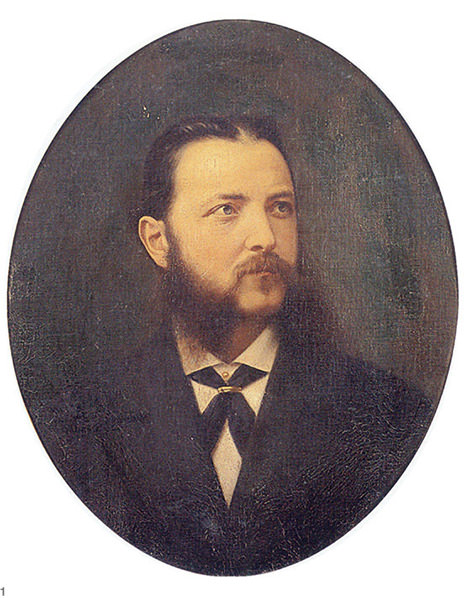
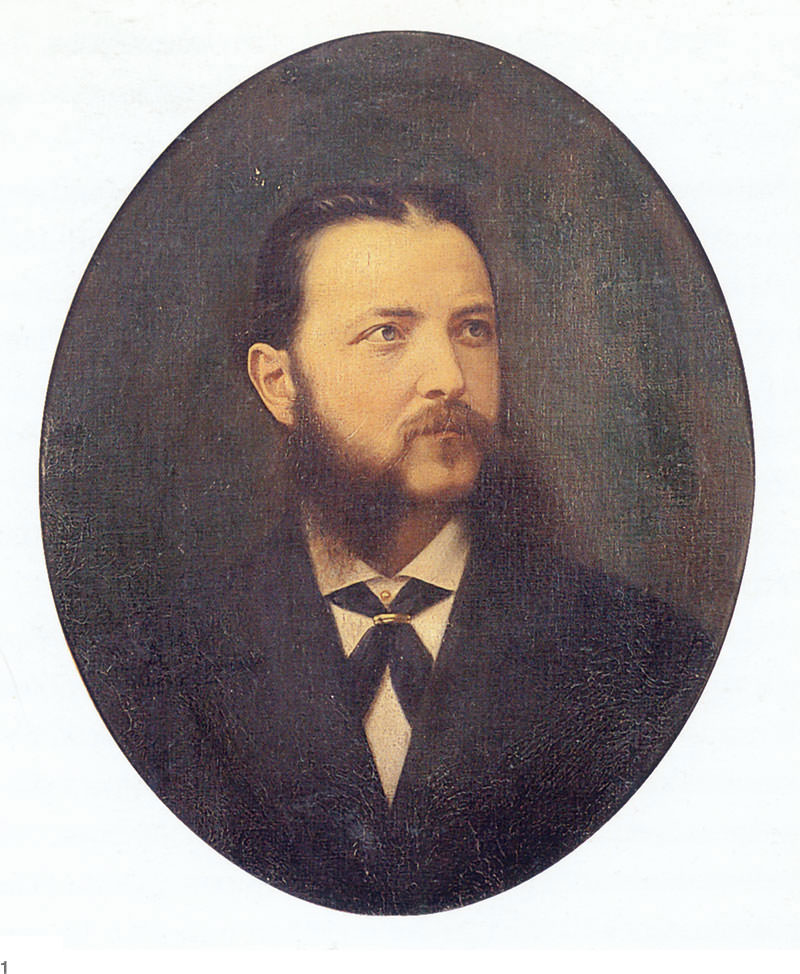
Luigi and Ferdinando Bocconi started their entrepreneurial adventure at the bottom of the ladder, first as shop boys in Lodi and then as pedlars selling fabrics and clothing. It was a very old profession that not only came with hardship but also implied building relations and circulating information and ideas. It was also the starting point from which you could set up a store, experience that the Bocconi Brothers shared with many other important Italian retail businesses. During these years they were also involved in the events that brought about the unification of Italy: Luigi fought with Garibaldi and Ferdinando took part in the war against organised banditry.



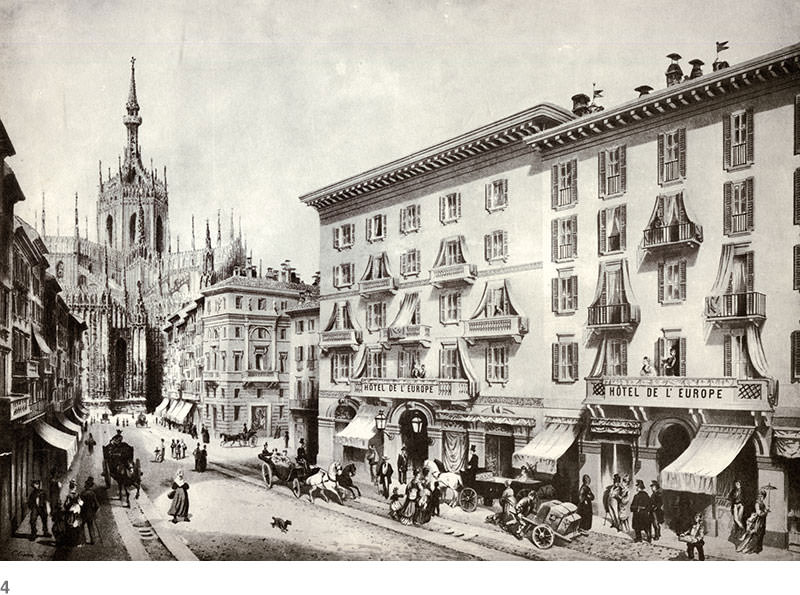

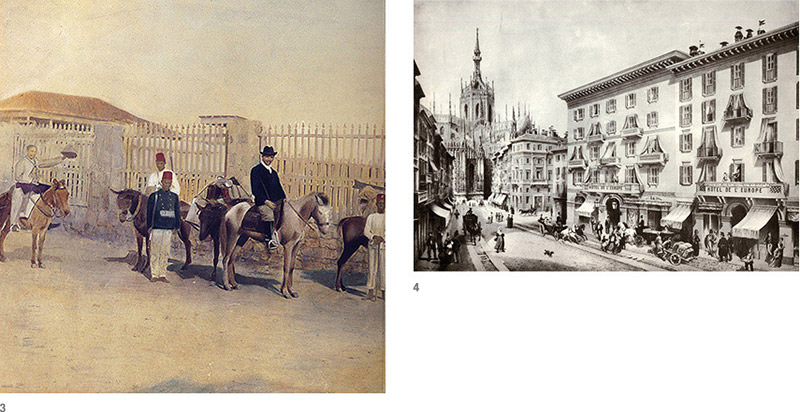

1 — Giacomo Grosso, Ritratto di Luigi Bocconi.
Milano, Università Commerciale Luigi Bocconi
2 — Ritratto di Ferdinando Bocconi.
Milano, Università Commerciale Luigi Bocconi
3 — Luigi Bocconi e gli Ascari ad Asmara, 1896.
Milano, Università Commerciale Luigi Bocconi
4 — C. Cima, L’Hôtel de l’Europe sul Corso, 1870 circa.
Milano, Civica Raccolta delle stampe Achille bertarelli
5 — Notifica di cessazione del negozio di telerie e cotonerie di Roberto Bocconi, padre di Ferdinando e Luigi, 1853.
Milano, Archivio storico Camera di Commercio
The city on display
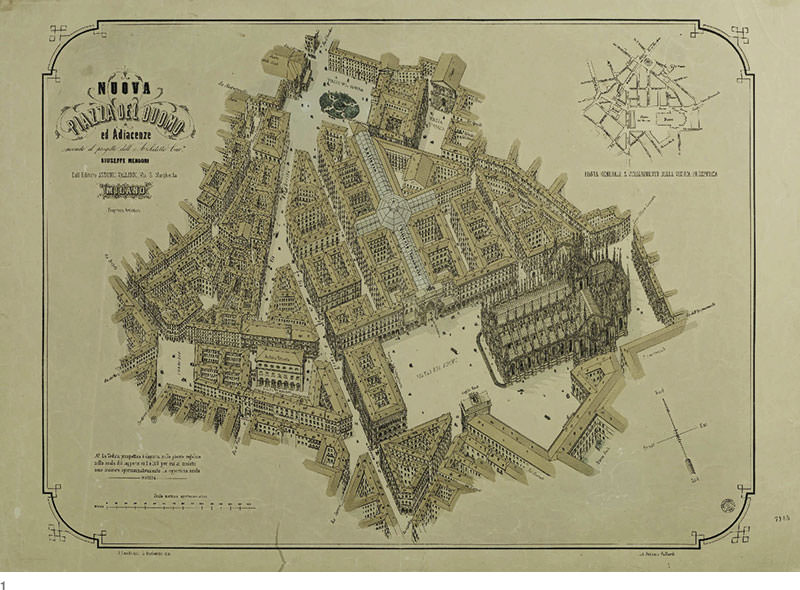

The “Magazzini Bocconi” store was established in a period marked by urban change that brought about new and more modern business and social models. In 1832, the “Galleria De Cristoforis” was built in the style of the Parisian passages a lively shopping arcade lined with small shops and cafés under a glass dome. It was the forerunner of the Galleria Vittorio Emanuele II (1878) created by Giuseppe Mengoni. The number of businesses in the city centre multiplied: cafés, pubs and restaurants. Shops became more and more specialised according to the type of merchandise they sold. The attention paid to exhibiting and advertising products, in particular the skill of decorating shop signs and window displays, would soon become a real form of art in the twentieth century.

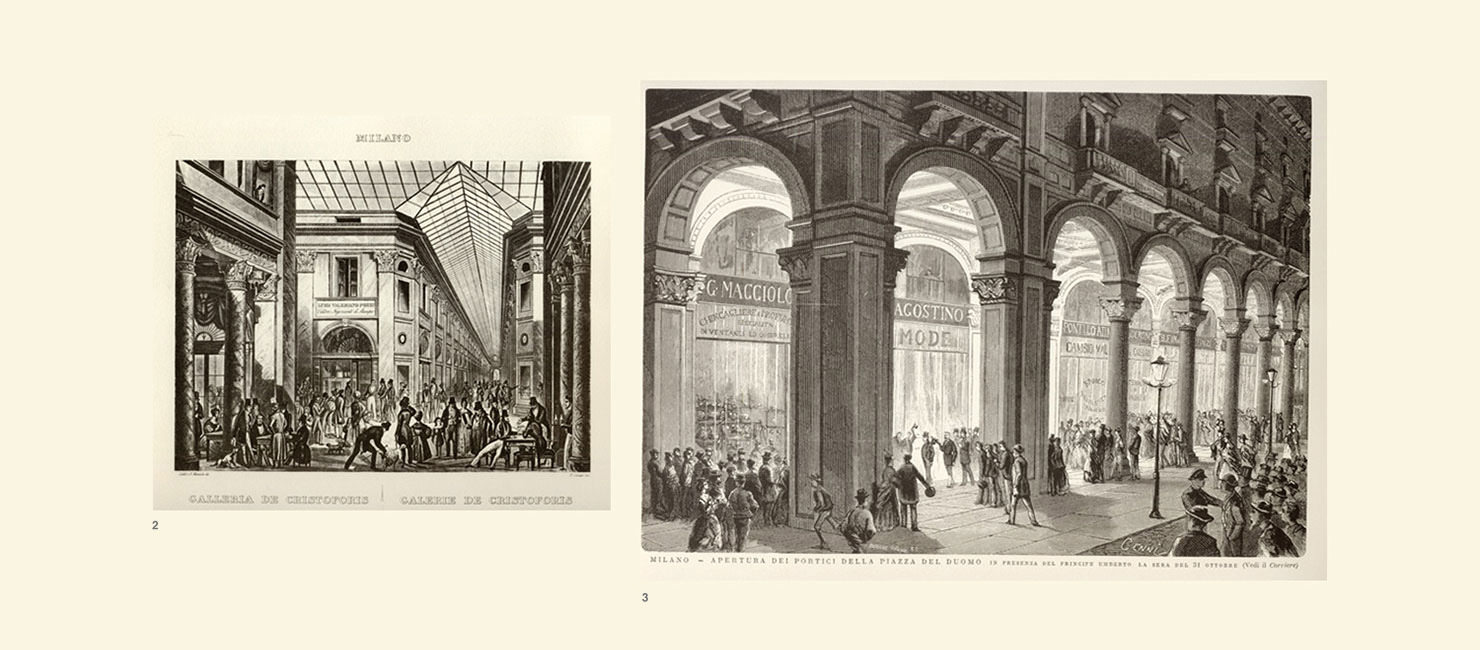
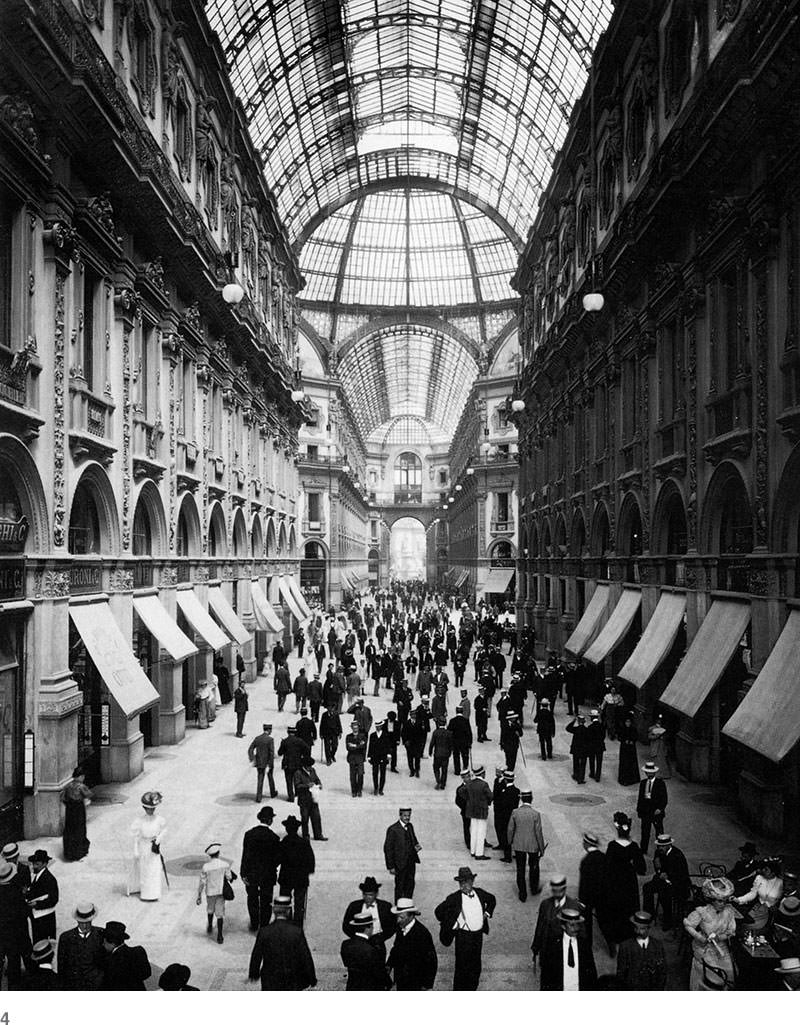
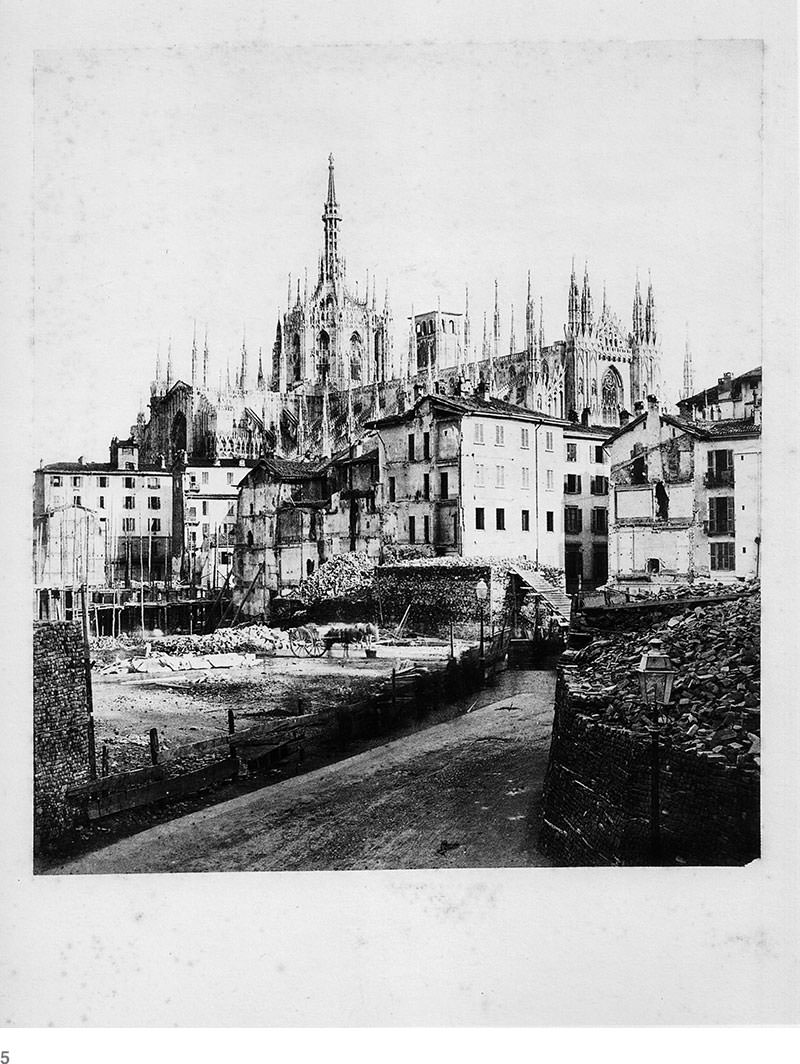
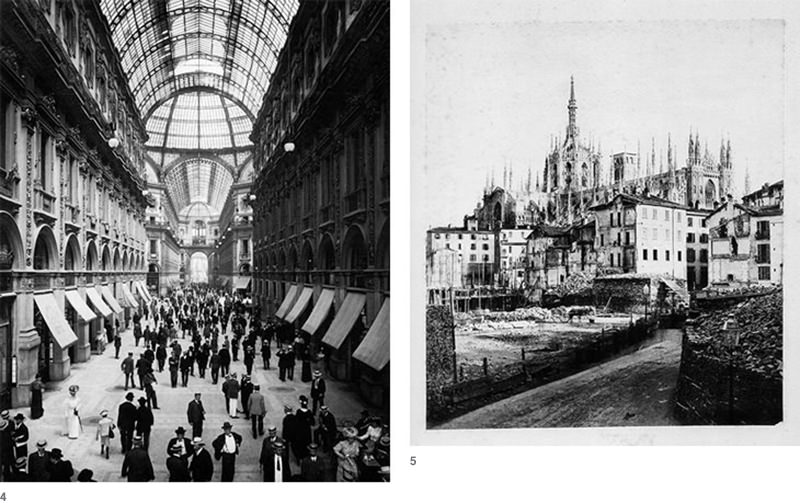
1 — Nuova piazza del Duomo e adiacenze secondo il progetto dell’architetto cavalier Giuseppe Mengoni, 1865.
Milano, Civica Raccolta delle stampe Achille Bertarelli
2 — F. Campi, La Galleria De Cristoforis, 1835-1838 circa.
Milano, Civica Raccolta delle stampe Achille Bertarelli
3 — Q. Cenni, Milano. Apertura dei portici settentrionali alla presenza del principe Umberto, 31 ottobre 1874.
Milano, Civica Raccolta delle stampe Achille Bertarelli
4 — Il passeggio in Galleria Vittorio Emanuele II, fine XIX secolo.
Milano, Archivio Fotografico Touring Club Italiano
5 — Demolizioni per la costruzione della Galleria a Milano, 1865.
Milano, Archivio Fotografico di Brera
Expositions
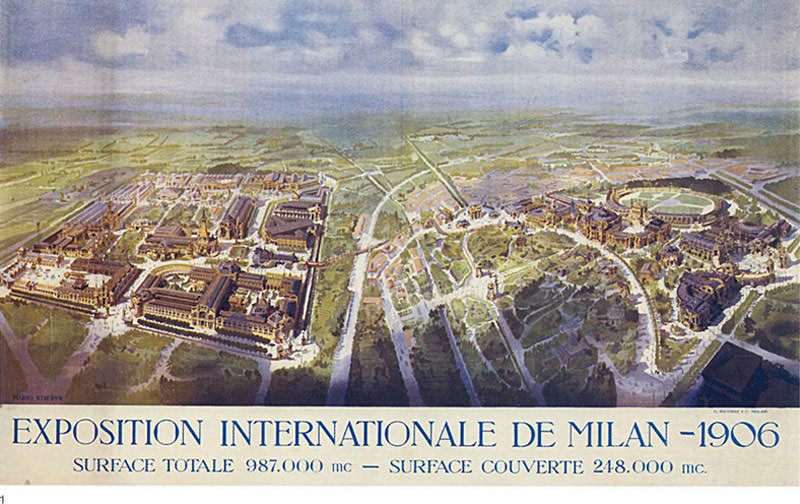

From the second half of the nineteenth century Milan started turning into the dynamic and modern city that we now know. The population growth was incredible and consequently the city started sprawling outwards. The structure of the city changed: while industrial sites further marked the suburbs, the city centre renewed its functions giving more predominance to services and commercial enterprises. The national exposition of 1881, in which the Bocconi Brothers took part with their own pavilion, and the universal exposition of 1906 provided Milan with the opportunity to manifest its industrial, commercial and cultural vocation, ever keen on new forms of modernity: products, fashion, technology, entertainment, commerce and advertising.
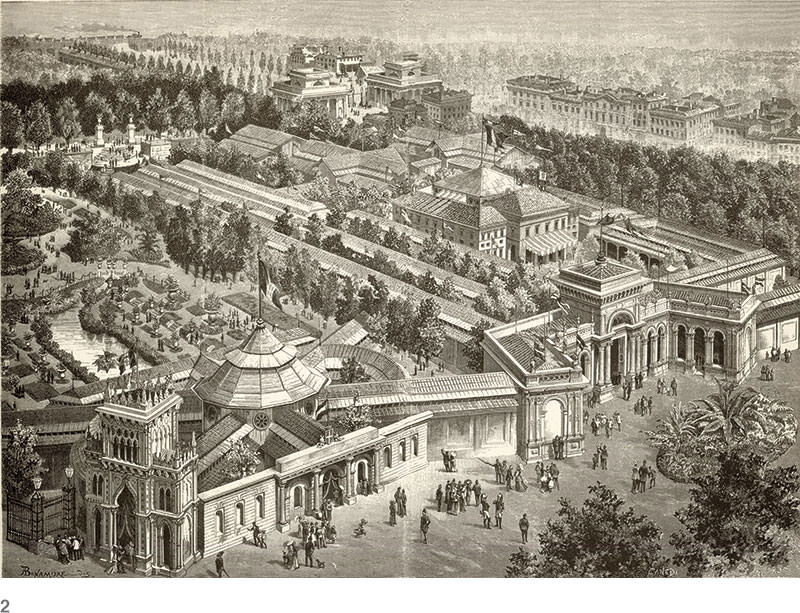


1 — Marius (Mario Stroppa), Exposition Internationale de Milan, 1906.
Milano, Civica Raccolta delle Stampe Achille Bertarelli
2 — Antonio Bonamore, Veduta a volo d’uccello dell’Esposizione Nazionale, 1881.
Milano, Civica Raccolta delle Stampe Achille Bertarelli
3 — Candiani, Il padiglione dei Fratelli Bocconi nella Galleria Centrale dell’Esposizione Nazionale di Milano, 1881
The first "Magazzini Bocconi" store
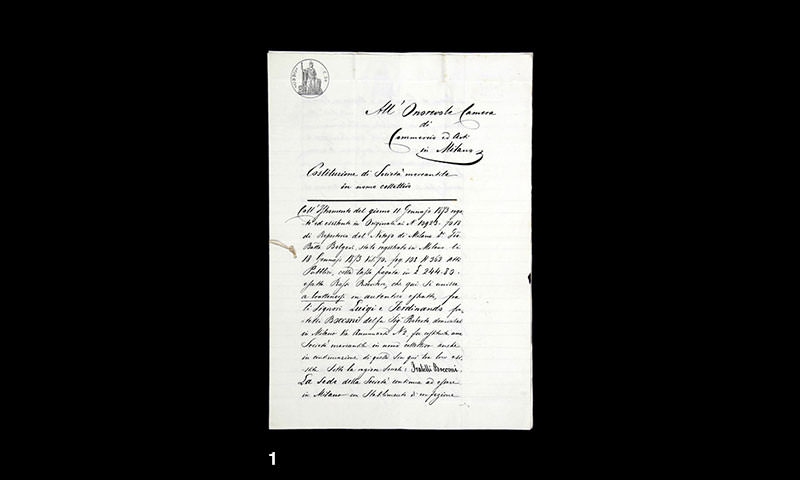

In 1865 the Bocconi Brothers opened their first clothes shop selling ready-to-wear garments. The shop was situated on the busy corner of Via Santa Radegonda and right from the start they showed how innovative they were by being among the first in Milan to use electric lighting to illuminate the small shop window as a way of attracting the attention of passers-by. From 1870 to 1877 they moved the business to Porta Nuova where they opened a stored called “Magazzino Livornese”. The ample space allowed the brothers to expand the range of merchandise. Here they introduced for the first time a fixed price, once again proving to be real forerunners.
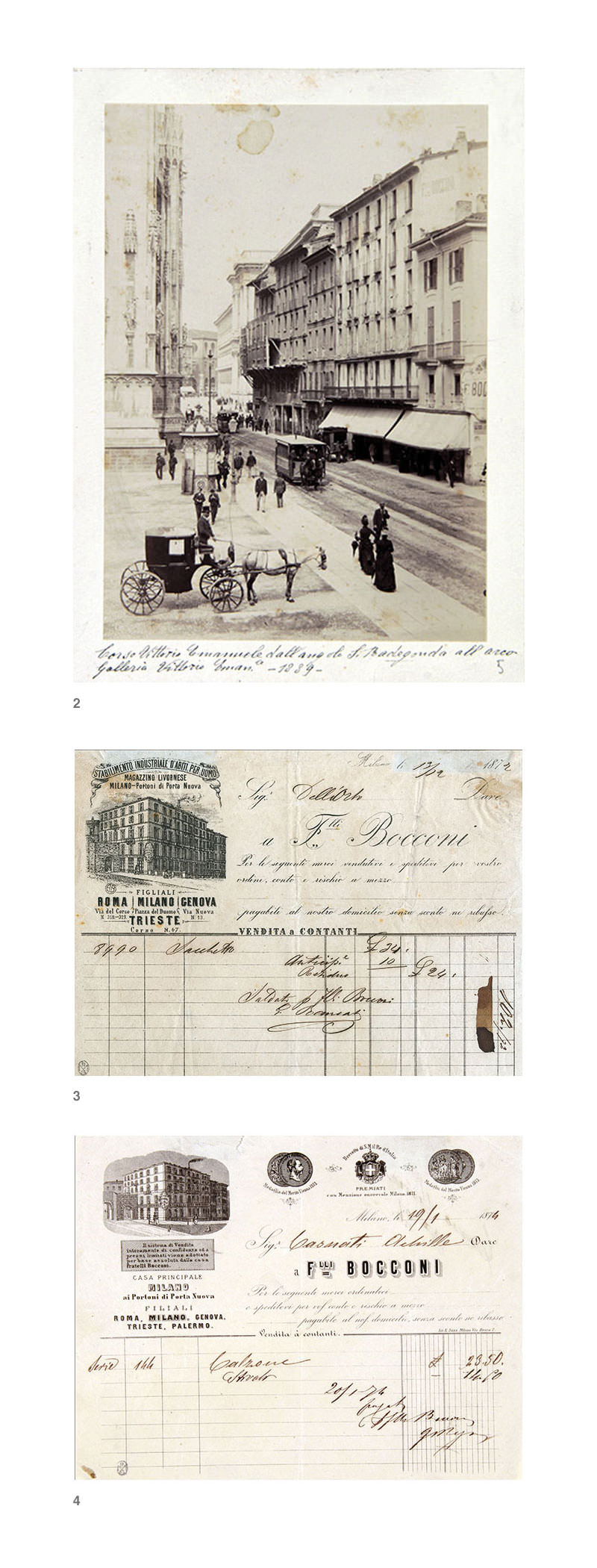
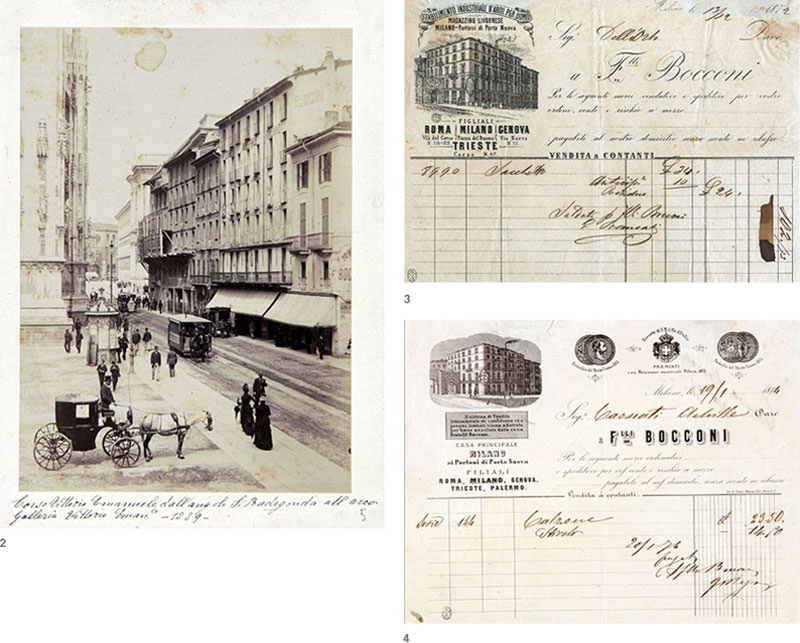
1 — Atto costitutivo della società mercantile Fratelli Bocconi, 1873.
Milano, Archivio Storico Camera di Commercio
2 — Corso Vittorio Emanuele II dall’angolo di Santa Radegonda, 1889 circa.
Milano, Civico Archivio Fotografico
3 / 4 — Ricevute del Magazzino Livornese, 1870 e 1874.
Milano, Civica Raccolta delle Stampe Achille Bertarelli
The "Alle città d’Italia" store
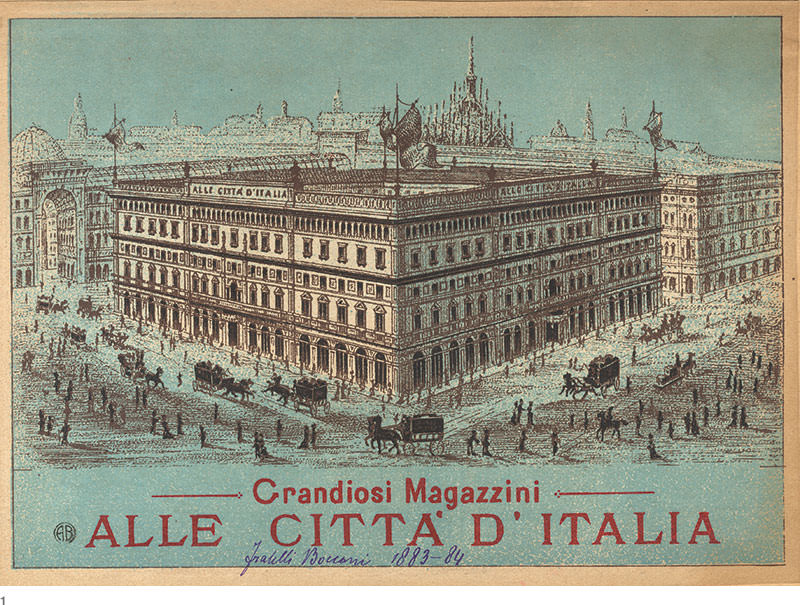
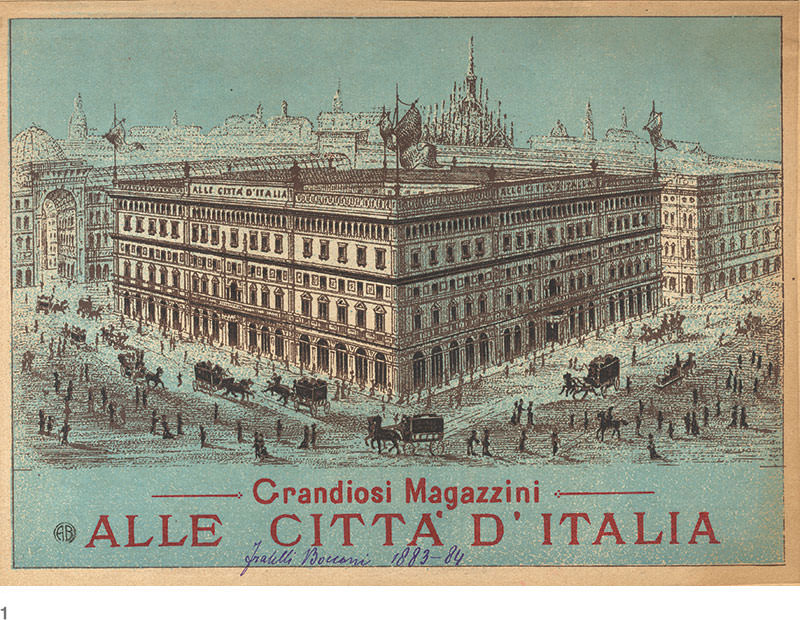
In September 1877 the Bocconi Brothers leased the extremely modern Hôtel Confortable, which had been build right next to the new Galleria Vittorio Emanuele II by the Marquis Alessandro Flori in 1873 and they turned it into the headquarters of their retail enterprise. The “Aux Villes d’Italie” was hence established, soon after renamed “Alle città d’Italia”, the first Italian department store with its large rooms, wide range of products and, most importantly, goods that were put on display, clearly visible from the street and inside the store. The department store was much admired for its magnificent English Gothic hall.
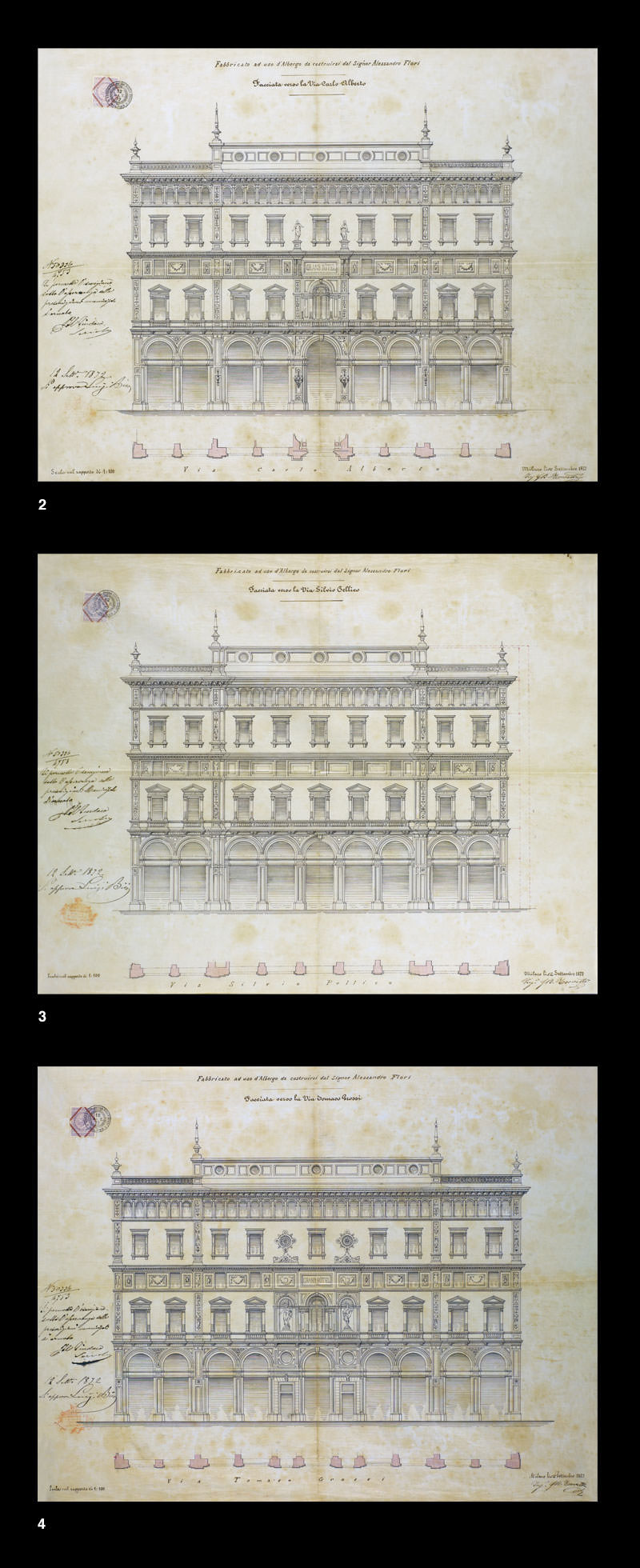

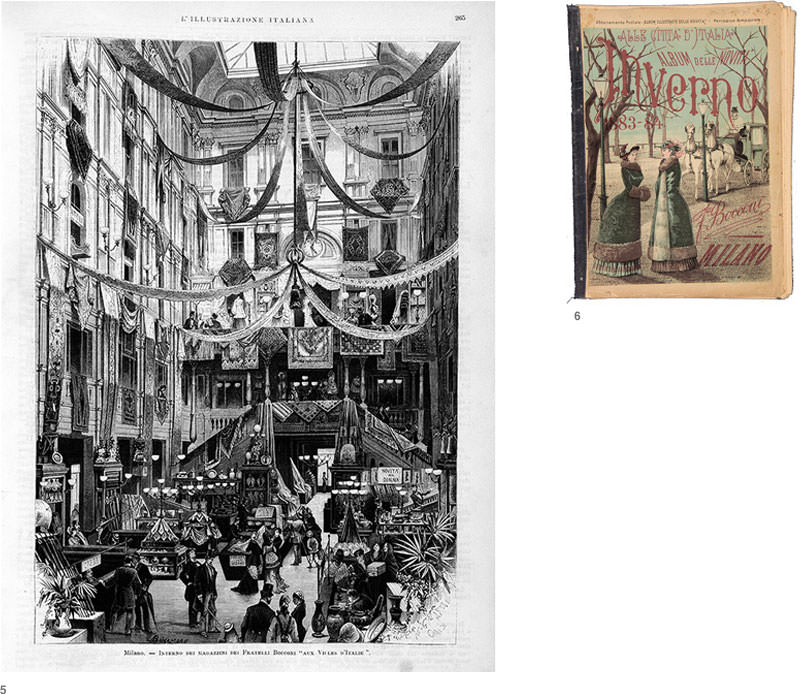

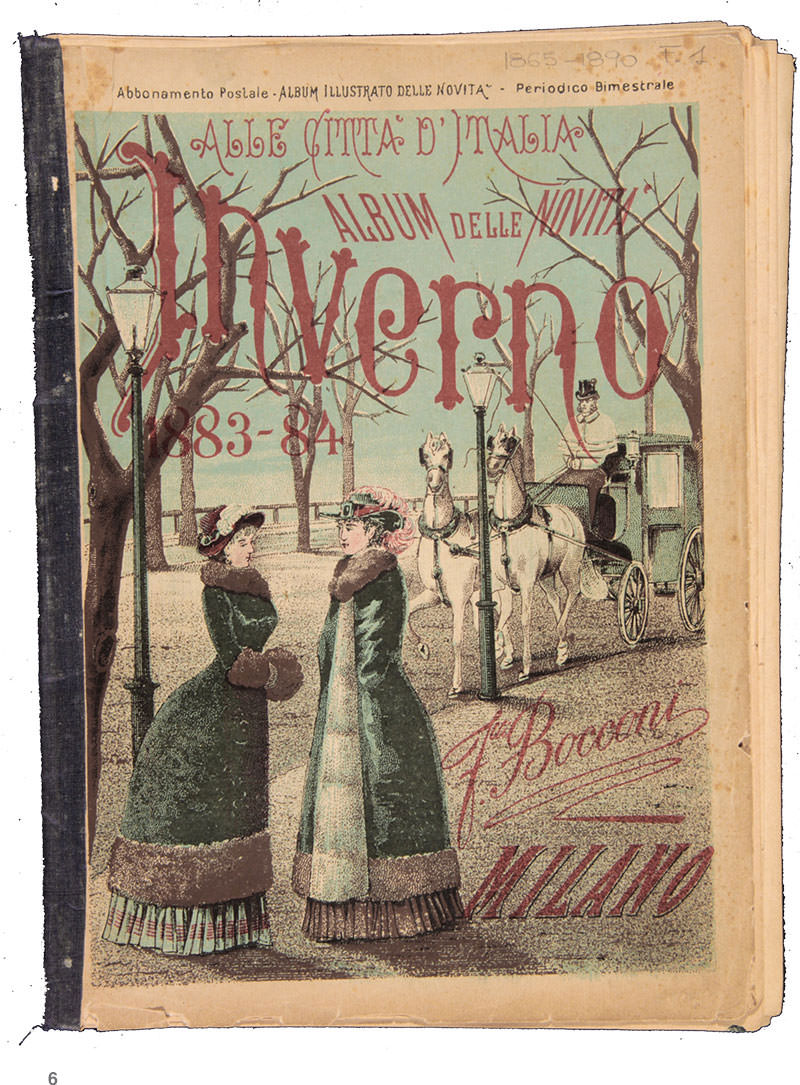
1 — Stampa pubblicitaria della sede dei magazzini Alle città d’Italia di via Tommaso Grossi e via Carlo Alberto, 1883.
Milano, Civica Raccolta delle Stampe Achille Bertarelli
2 / 3 / 4 — G.B. Torretta, Fabbricato ad uso d’Albergo da costruirsi dal Signor Alessandro Flori. Disegni delle facciate verso via Silvio Pellico, via Tommaso Grossi, via Carlo Alberto, 1872.
Milano, Archivio Storico Civico - Biblioteca Trivulziana
5 — Interno dei magazzini Aux Villes d’Italie, 1879.
Milano, Civica Raccolta delle Stampe Achille Bertarelli
6 — Copertina del catalogo dei magazzini Alle città d’Italia Inverno 1883-1884.
Milano, Civica Raccolta delle Stampe Achille Bertarelli
The new store
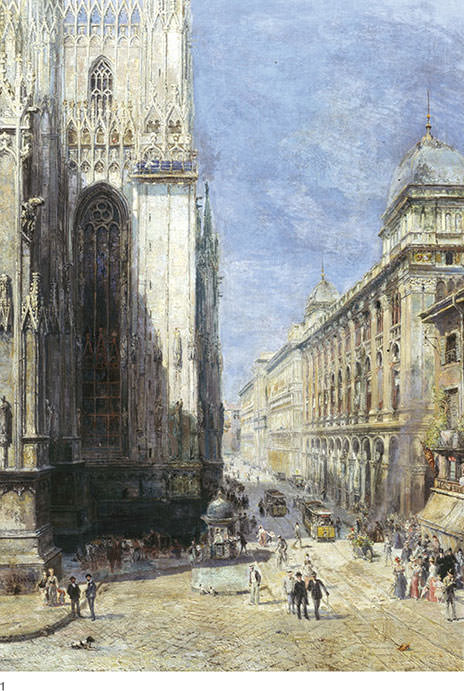

The new building of the “Magazzini Bocconi” was inaugurated on 22nd October 1889. Construction work had started in 1887 and the building designed by the architect Giovanni Giachi was completed after two years of frenzied activity. With three sweeping façades, it stood in the same area next to the Duomo where now stands the present day la Rinascente, between Via San Raffaele and Via Santa Radegonda. Modern and functional, it was avant-garde in terms of design and retail space. The large and high windows set between iron columns, the vast rows of shelves facing the monumental central stair case and the profusion of merchandise on display made it the unequivocal model for the whole country.

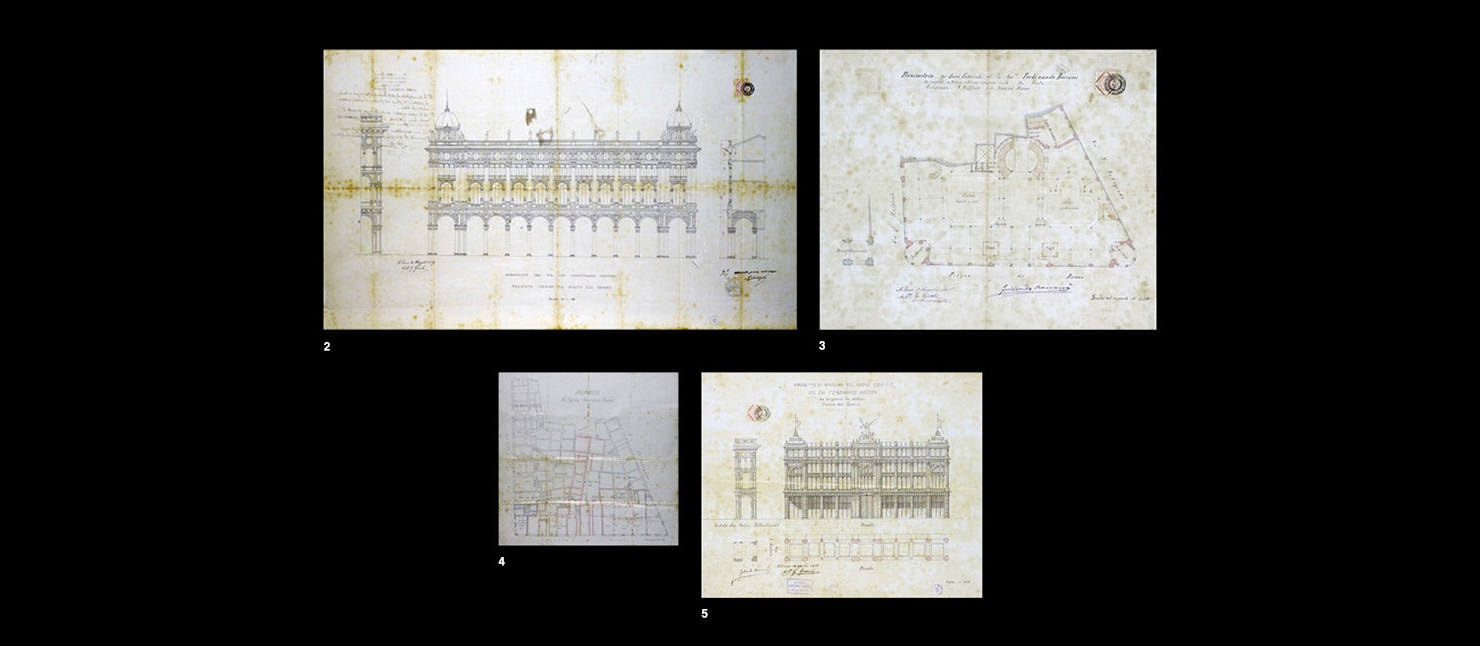

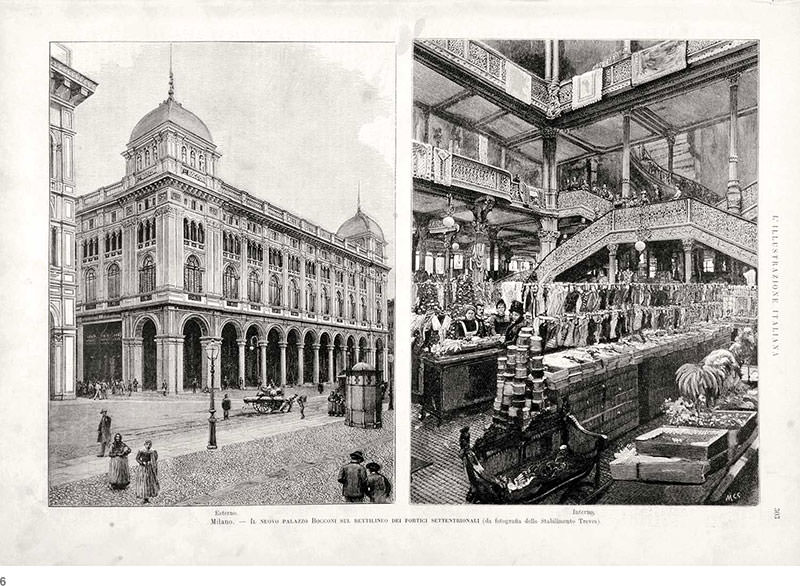
“A real throng of thousands of people came for days from every part of the great capital of Lombardy and from the nearby towns and villages to see the new venue built by the Bocconi Brothers in Piazza Duomo to host their department store Alle città d’Italia. It was a general tribute of admiration for the grand and majestic outcome of the project. [...] Next to the magnificent creation of medieval mysticisms, by the monument made of marble, stood the large glass and iron building, an enormous shop, that in a single glance and turn of the eyes revealed all the details of its dynamic, hectic life” (Casa Bocconi, “LIllustrazione italiana”, 10 November 1889).

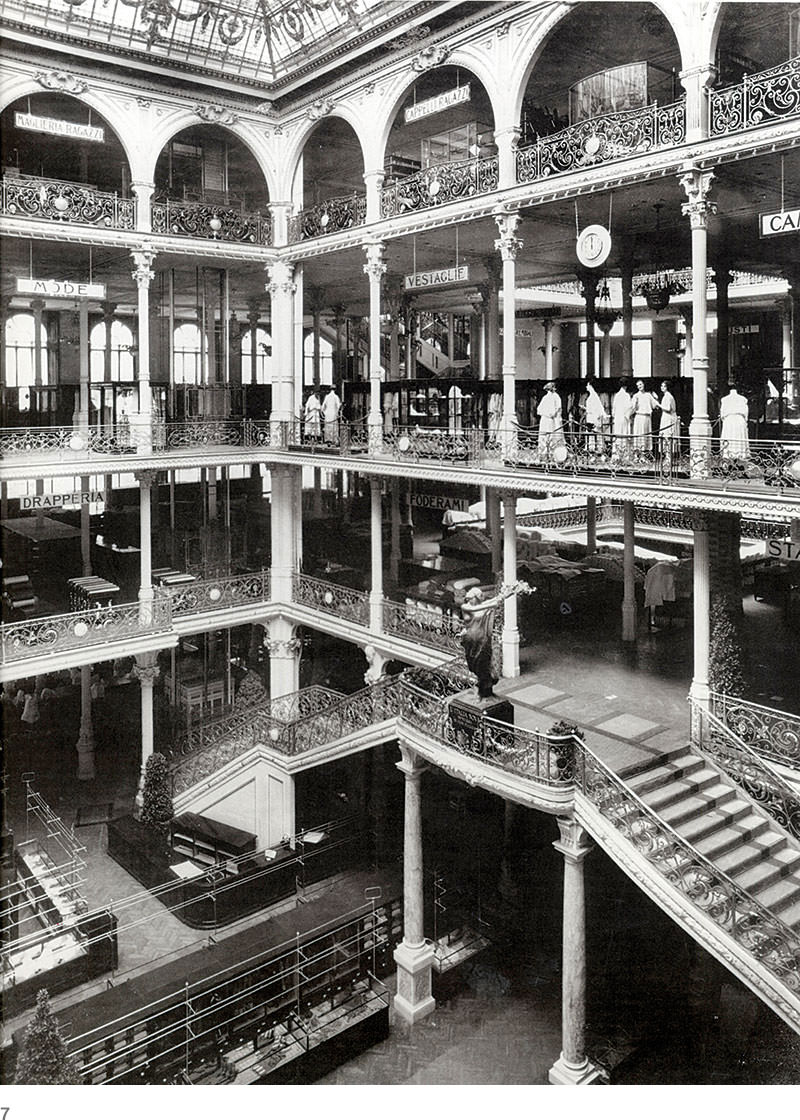

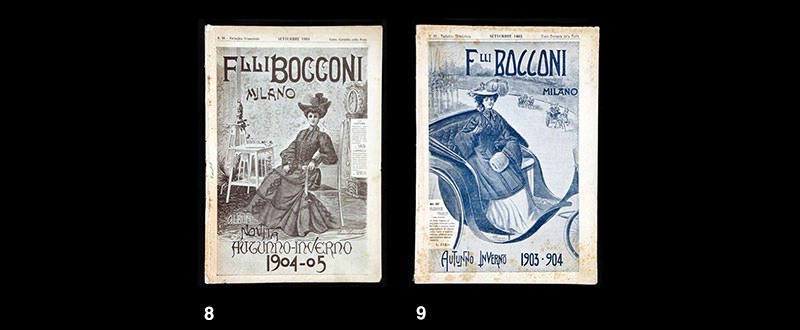
1 — Pierre Henri Théodore Tetar van Elven, Il duomo di Milano visto dalla corsia dei Servi, 1901.
Collezione Intesa Sanpaolo
2 / 3 — Giovanni Giachi, Fabbricato del Signor Cavaliere Ferdinando Bocconi. Progetti per la facciata principale verso piazza del Duomo, 1886-1887.
Milano, Archivio Storico Civico - Biblioteca Trivulziana
4 / 5 — Pianta dell’area di proprietà di Ferdinando Bocconi e Planimetria del nuovo fabbricato, 1885 circa.
Milano, Archivio Storico Civico - Biblioteca Trivulziana
6 — Il nuovo palazzo Bocconi, 1889.
Milano, Civica Raccolta delle Stampe Achille Bertarelli
7 — Veduta interna dei Grandi Magazzini la Rinascente, 1931.
Milano, Archivio Fotografico Touring Club Italiano
8 / 9 — Copertine del catalogo Fratelli Bocconi Autunno-Inverno 1903-1904 e 1904-1905.
Milano, Civica Raccolta delle Stampe Achille Bertarelli
The fire and the rebirth
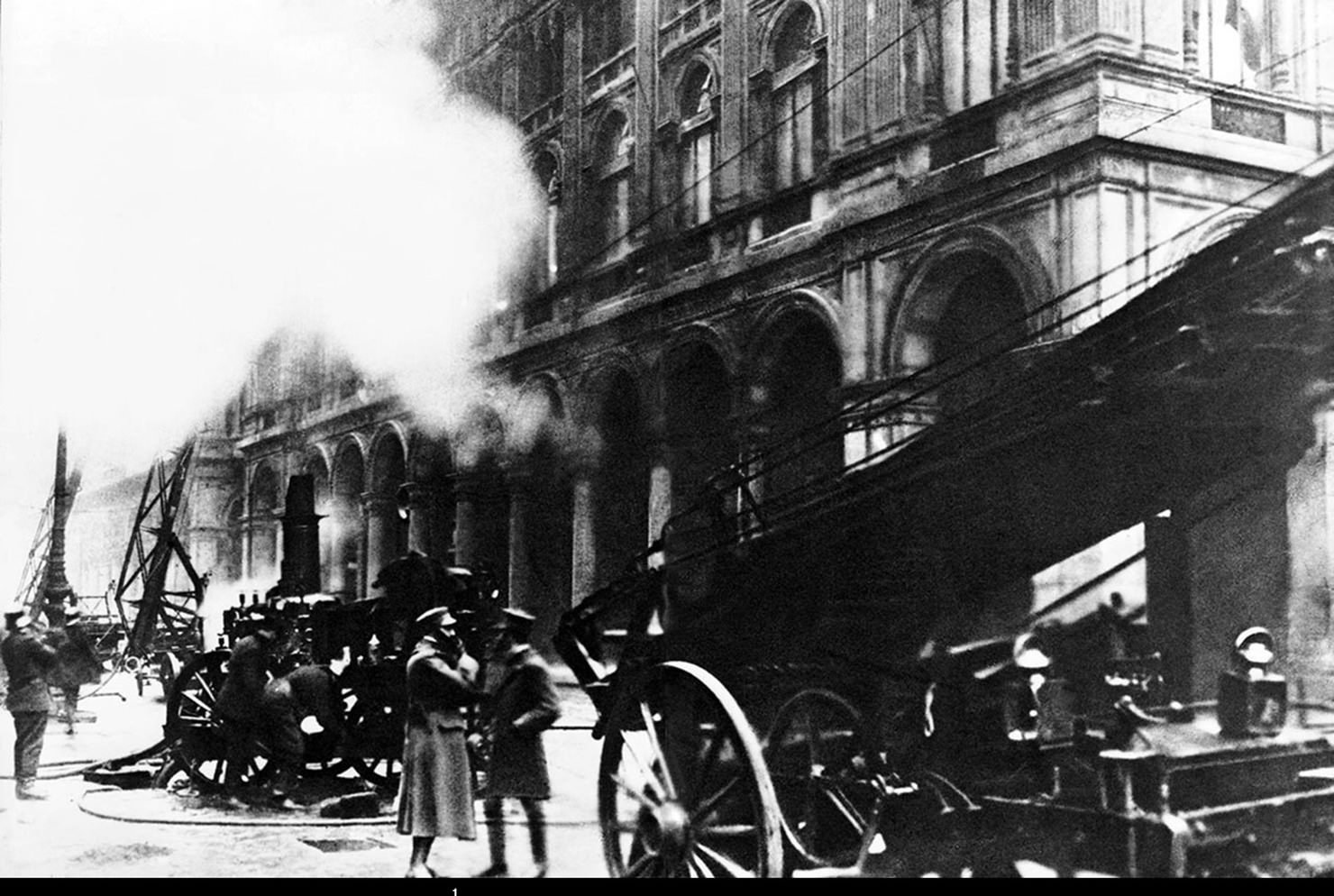

A fire completely destroyed Palazzo Bocconi, where the new department store of la Rinascente was situated, on Christmas night of 1918. “All night and all morning and even in the afternoon the flames flared up here and there. But the robust external frame of the building was saved together with the magnificent façade, apart from the lateral domes that had burnt like enormous torches from the first hour of the disaster” (“Il Sole”, 26-27 December 1918). Reconstruction work commenced after a short time and the aim was to surpass the previous building in terms of modernity and style. La Rinascente inaugurated the new store in 1921, fulfilling all expectations.
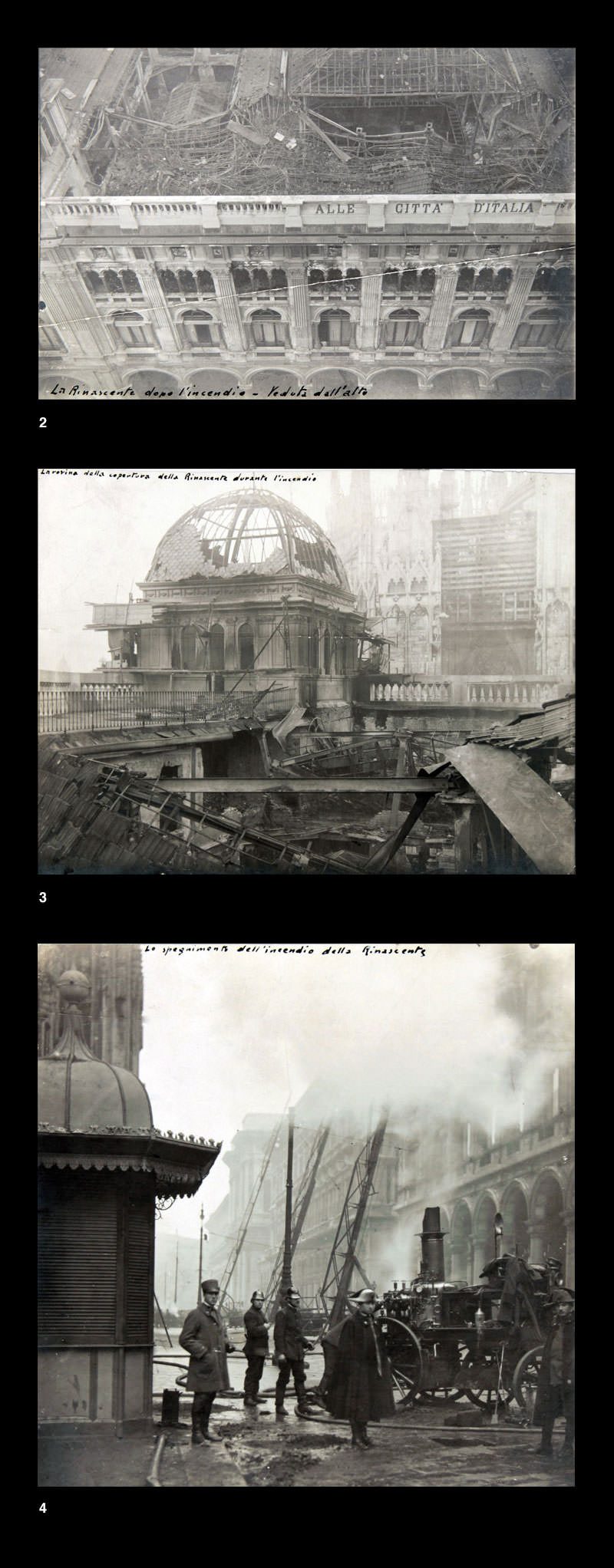
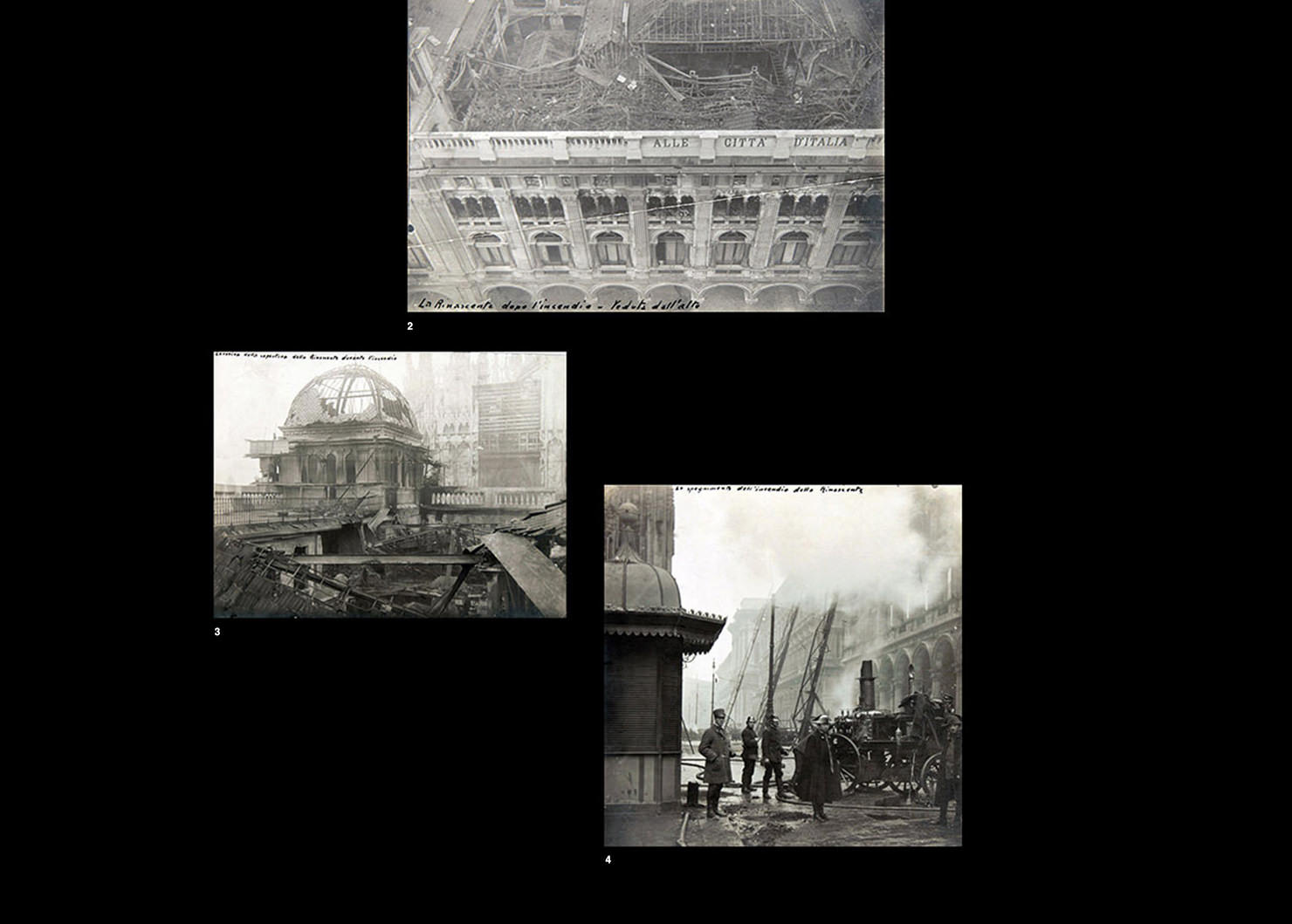
1 — La Rinascente danneggiata dall’incendio, 1918.
Milano, Archivi Farabola
2 / 3 / 4 — L’incendio alla Rinascente. I danni e le operazioni dei vigili del fuoco, 1918.
Milano, Civico Archivio Fotografico
From Milan to the whole of Italy

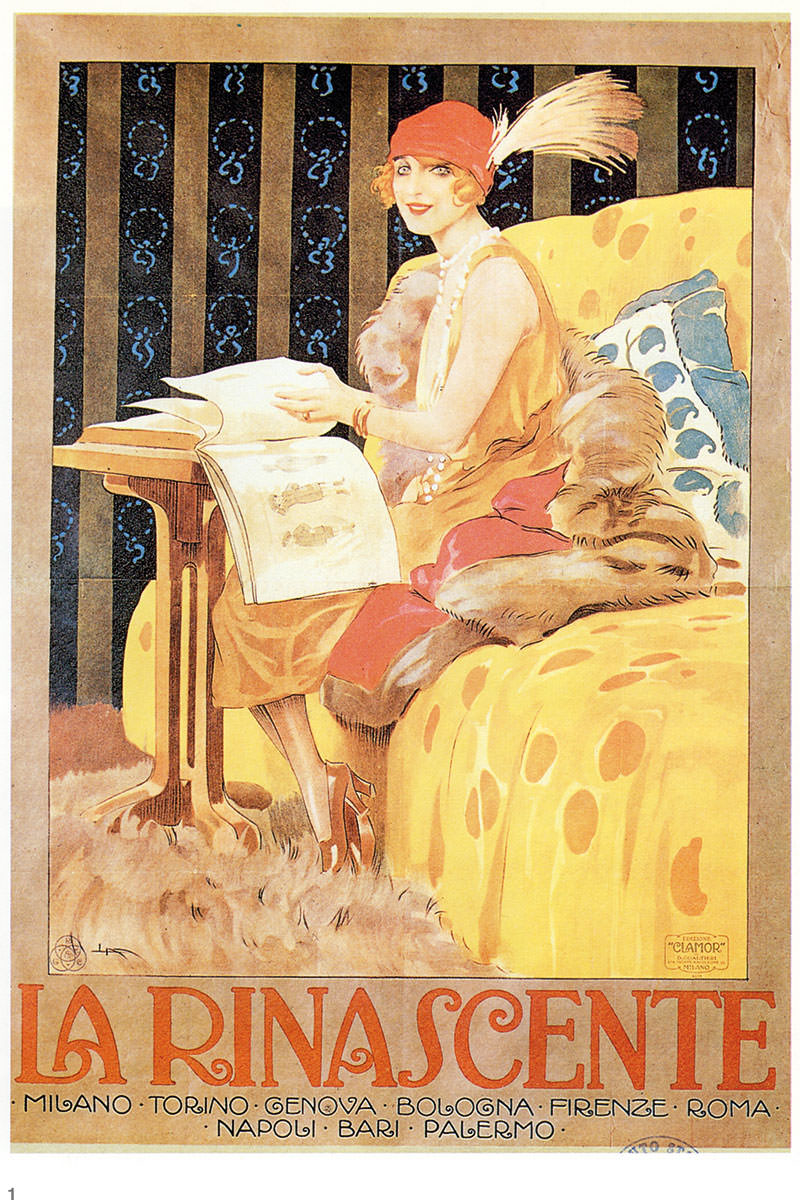
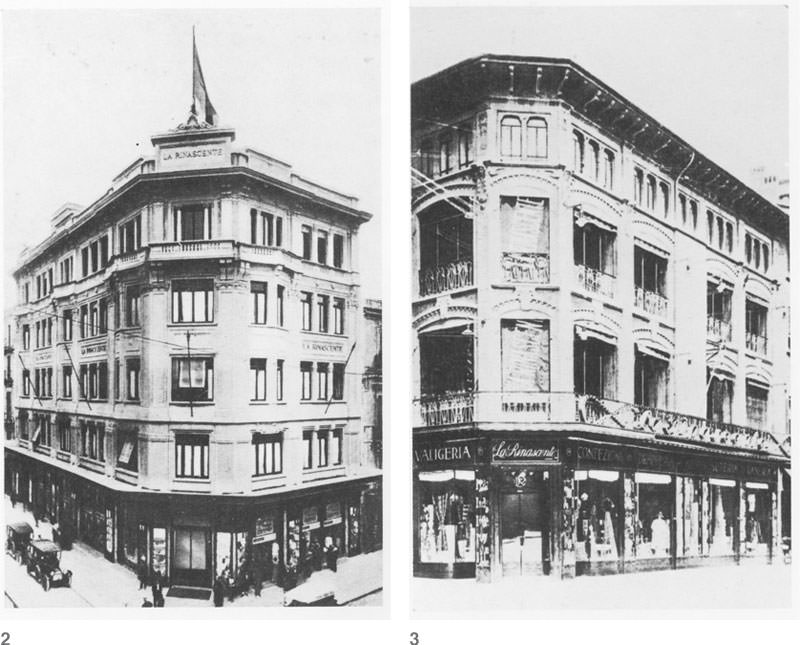
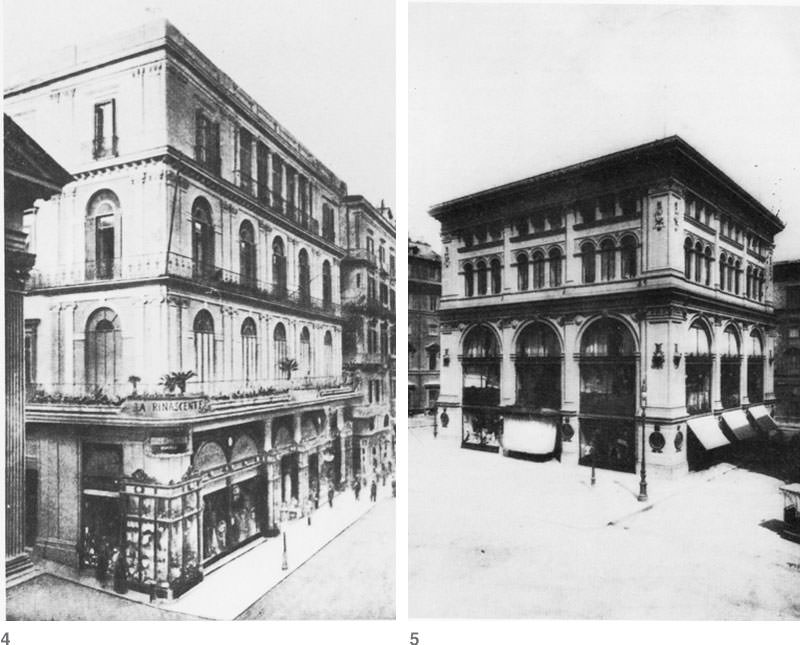


From 1869, the Bocconi Brothers started opening department stores in the main cities around the country. At the turn of the new century there were 9 branches: Milan, Rome, Genoa, Turin, Palermo, Naples, Venice, Florence and Bologna and a purchasing office in Paris. On 11th December 1887 the new store was opened in Piazza Colonna, Rome. Giulio De Angelis had designed the store and it represented the first building in Italy solely built for commercial purposes.
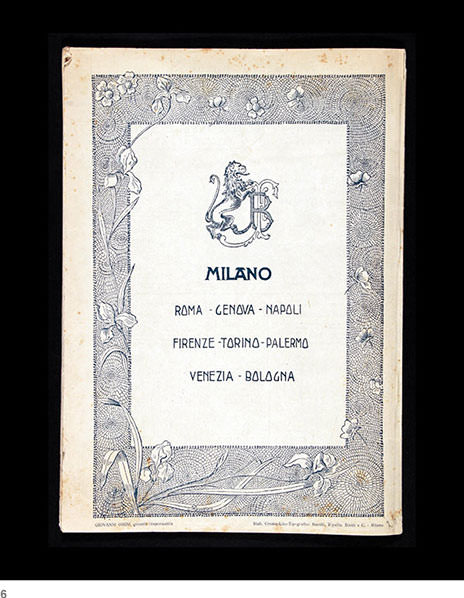
1 — Leopoldo Metlicovitz, Manifesto pubblicitario per la Rinascente, 1913.
Milano, Archivio storico Ricordi
2 — Veduta dei Magazzini la Rinascente a Bari, inizi XX secolo
3 — Veduta dei Magazzini la Rinascente a Bologna, inizi XX secolo
4 — Veduta dei Magazzini la Rinascente a Napoli, inizi XX secolo
5 — Veduta dei Magazzini la Rinascente a Roma, inizi XX secolo
6 — Pagina del catalogo dei Magazzini Bocconi con l’elenco delle città sedi di filiali, 1903.
Milano, Civica Raccolta delle Stampe Achille Bertarelli
Customers and staff
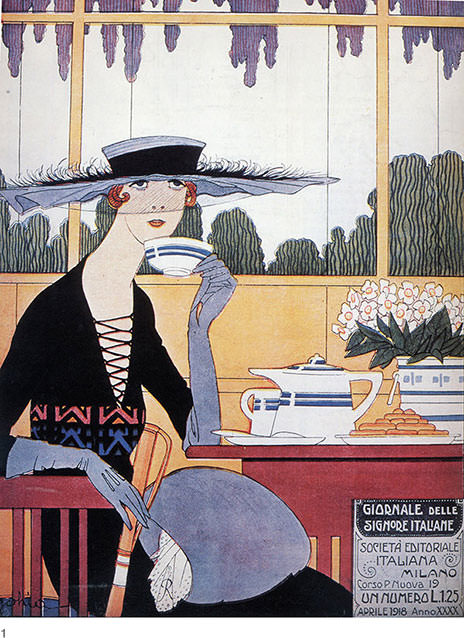

Right from the start, department stores were conceived as a visual spectacle so as to attract potential customers inside and make them enjoy the experience of shopping without having in mind anything in particular that they wanted to buy. The ample choice of goods, made-to- measure and ready-to-wear garments turned them into the favourite destination of the middle-classes, consisting of professionals and white-collar workers employed in public administration, commerce or industry, who entrusted their image to a company that was always up-to-date in terms of fashion and style and that was able to meet all their needs. The male and female sales assistants, there to serve customers, were the protagonists of the history of the “Magazzini Bocconi”, well known for their “good manners and their unchanging courtesy”.

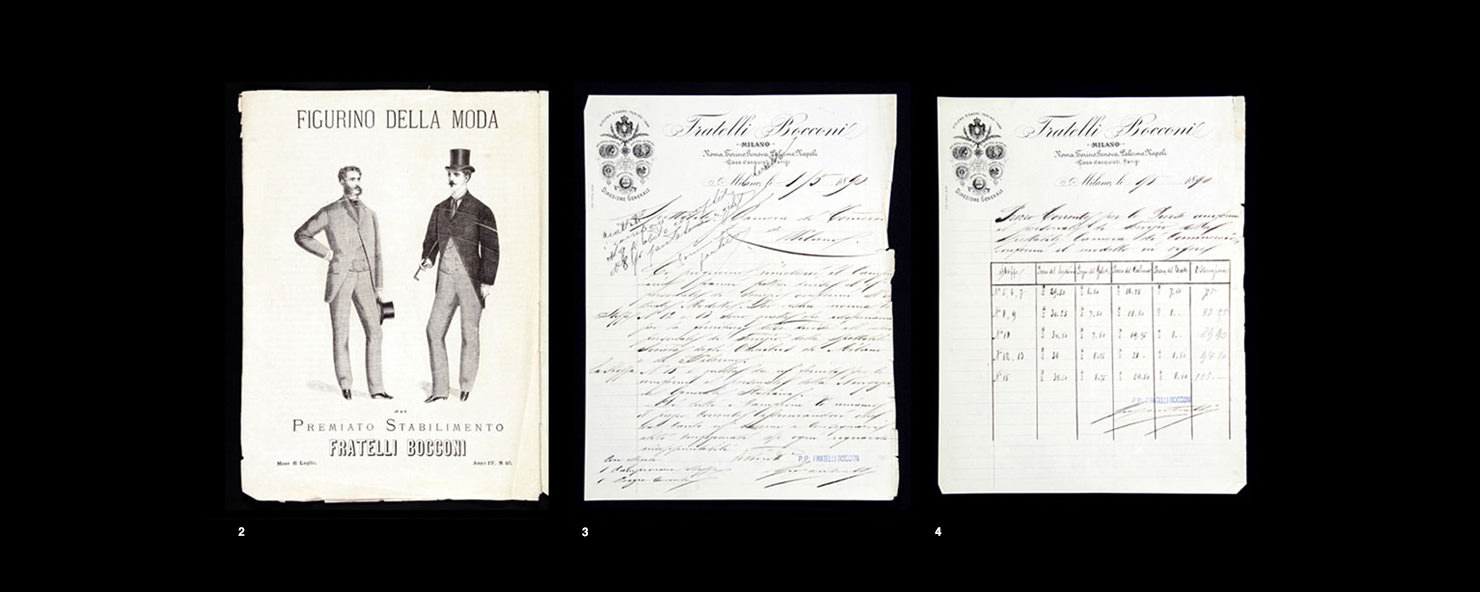
1 — Copertina del Giornale delle signore italiane, aprile 1918
2 — Pagina del catalogo Figurino della moda, luglio 1875.
Milano, Civica Raccolta delle Stampe Achille Bertarelli
3 / 4 — Offerta da parte dei Magazzini Bocconi alla Camera di Commercio di Milano per il confezionamento di divise per portieri, 1890.
Milano, Archivio Storico Camera di Commercio
Catalogues
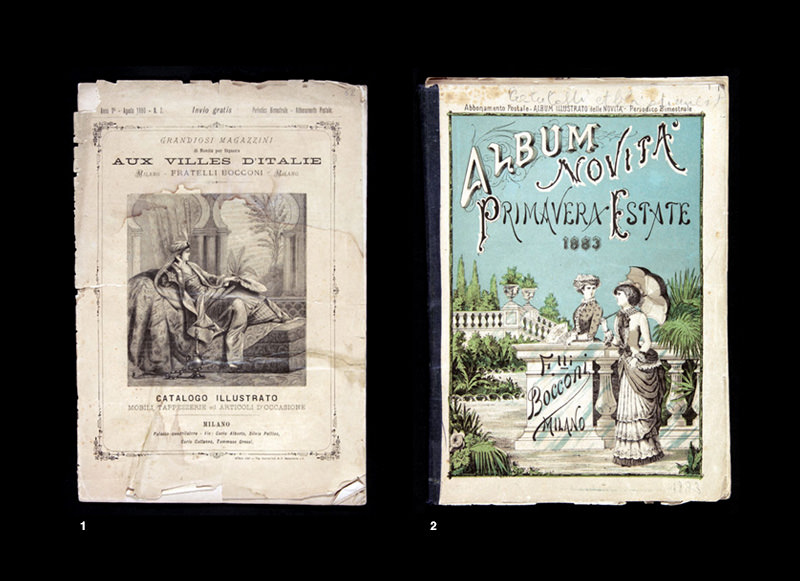
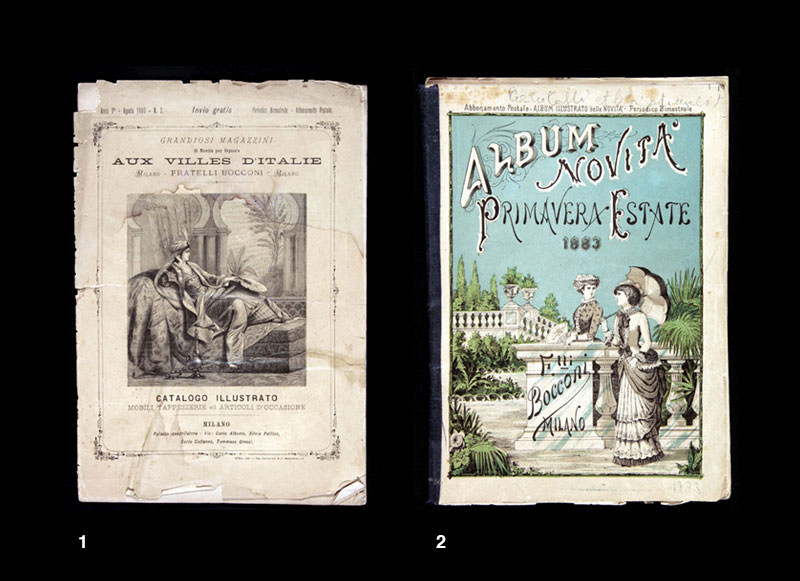
New sales models implied the use of new marketing and advertising tools, the most important of these being the catalogue of the products. Created to meet the demands of mail-order businesses, catalogues soon became an important means of communication to update customers and a powerful advertising tool. But they also represented an opportunity to experiment visually and graphically with a progressively increasing number of images and pictures. The subsequent introduction of colour and photographs transformed the function of catalogues from being merely informative to sophisticated tools of persuasion.
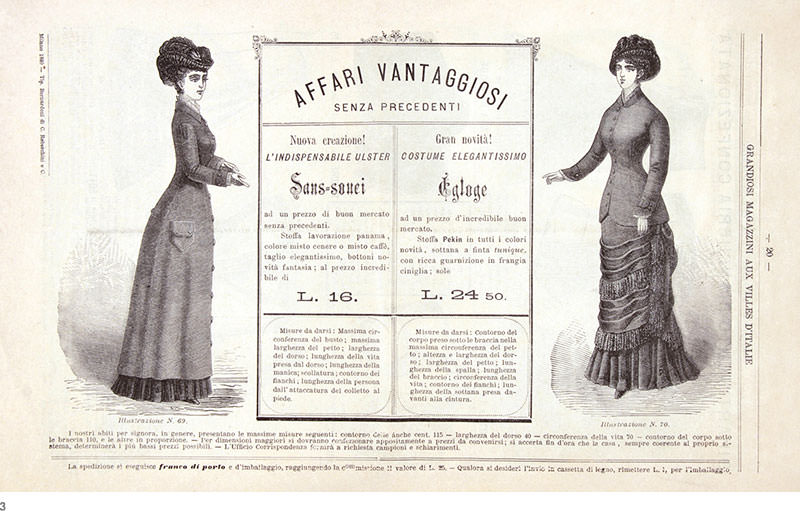
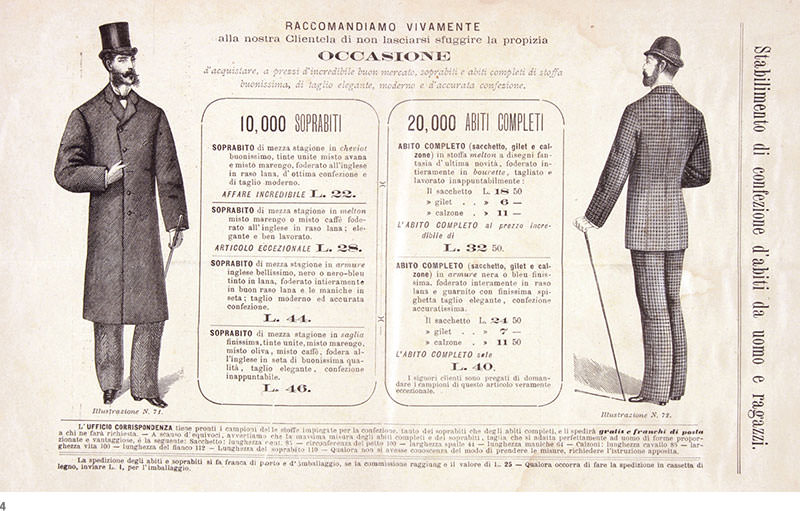

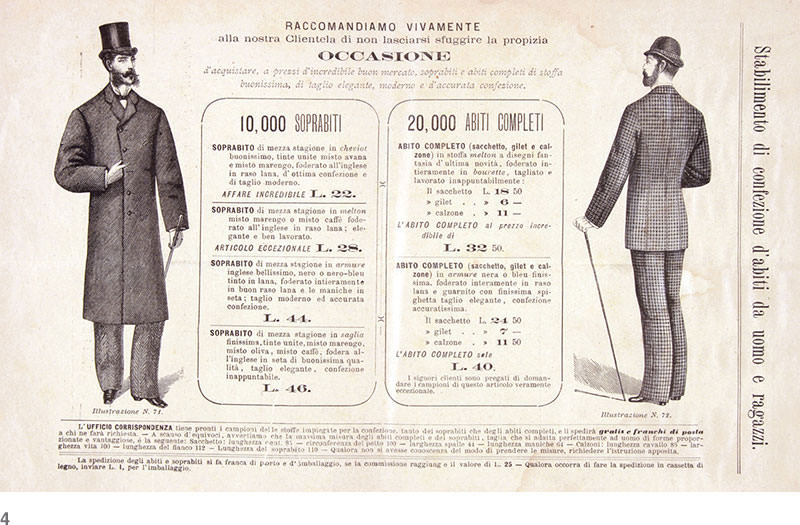

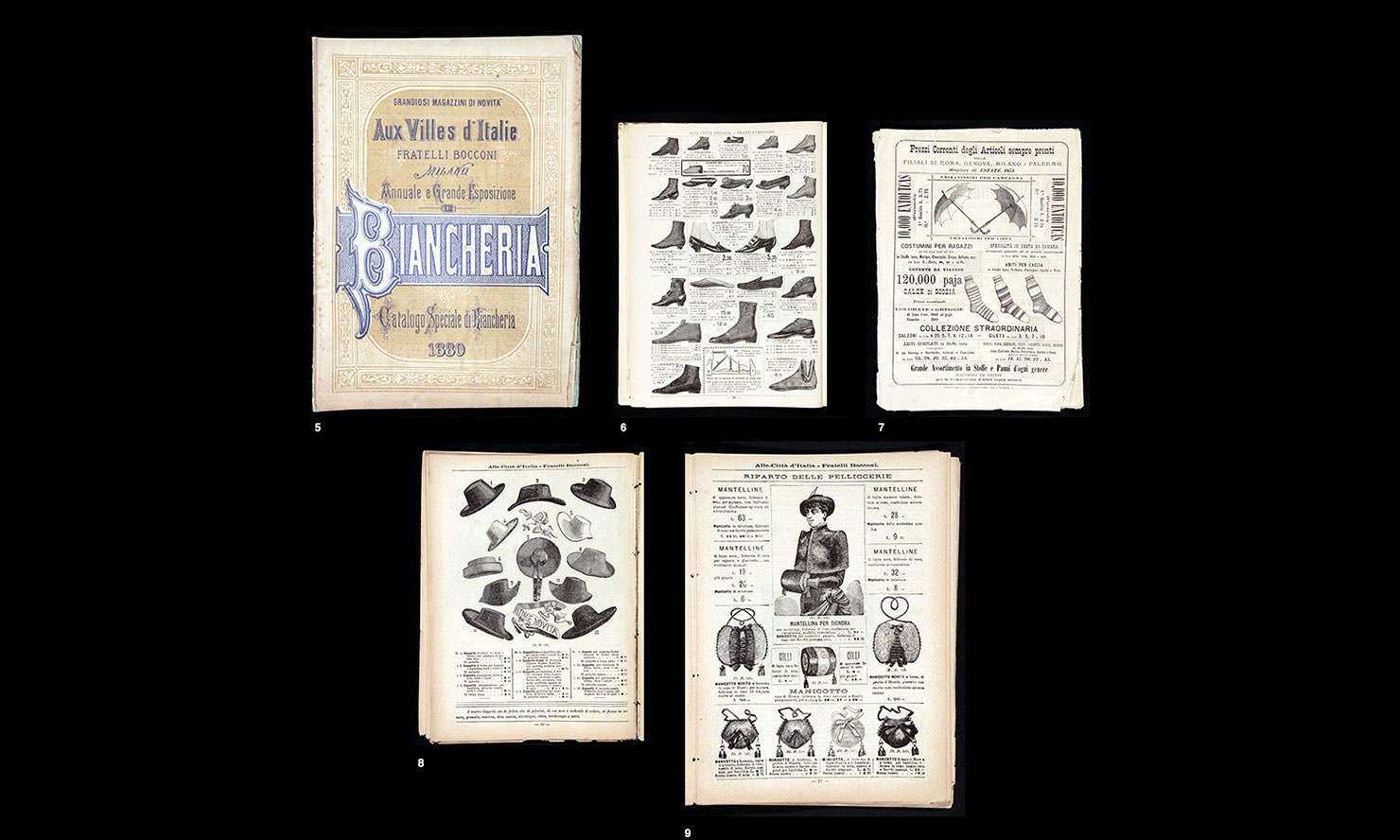
1 — Copertina del catalogo illustrato Grandiosi Magazzini Aux Villes d’Italie, 1880.
Milano, Civica Raccolta delle Stampe Achille Bertarelli
2 — Copertina dell’Album Novità Primavera-Estate 1883.
Milano, Civica Raccolta delle Stampe Achille Bertarelli
3 — Pagina interna del catalogo Grandiosi Magazzini Aux Villes d’Italie, 1880.
Milano, Civica Raccolta delle Stampe Achille Bertarelli
4 — Pagina interna del catalogo Figurino della moda, luglio 1875.
Milano, Civica Raccolta delle Stampe Achille Bertarelli
5 — Copertina del catalogo speciale di biancheria dei magazzini Aux Villes d’Italie, 1880.
Milano, Civica Raccolta delle Stampe Achille Bertarelli
6 — Pagina interna del catalogo Fratelli Bocconi Autunno-Inverno 1903-1904, settembre 1903.
Milano, Civica Raccolta delle Stampe Achille Bertarelli
7 — Pagina interna del catalogo Figurino della moda, luglio 1875.
Milano, Civica Raccolta delle Stampe Achille Bertarelli
8 / 9 — Pagine interne del catalogo Alle città d’Italia, 1883.
Milano, Civica Raccolta delle Stampe Achille Bertarelli
Elegant Milan

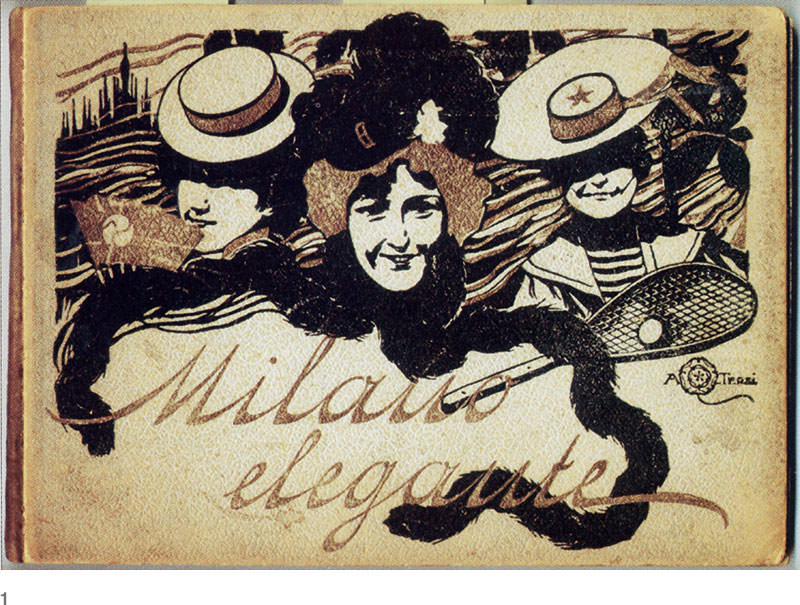
As a result of the growth of the market for consumer goods, advertising started affirming itself as the new art of persuasions from the second half of the nineteenth century. The first classified advertisements consisting of just text appeared in the newspapers. These were soon replaced by adverts with drawings and sketches. Subsequently innovative printing techniques made it possible to create large spreads and colour prints. In addition to illustrated papers, which dominated as a means of marketing communication, other printed formats such as catalogues and posters were developed to advertise goods. The Bocconi Brothers, ever attentive to the latest methods, experimented with every means of communication to advertise their products, including dropping advertising flyers from a hot-air balloon.
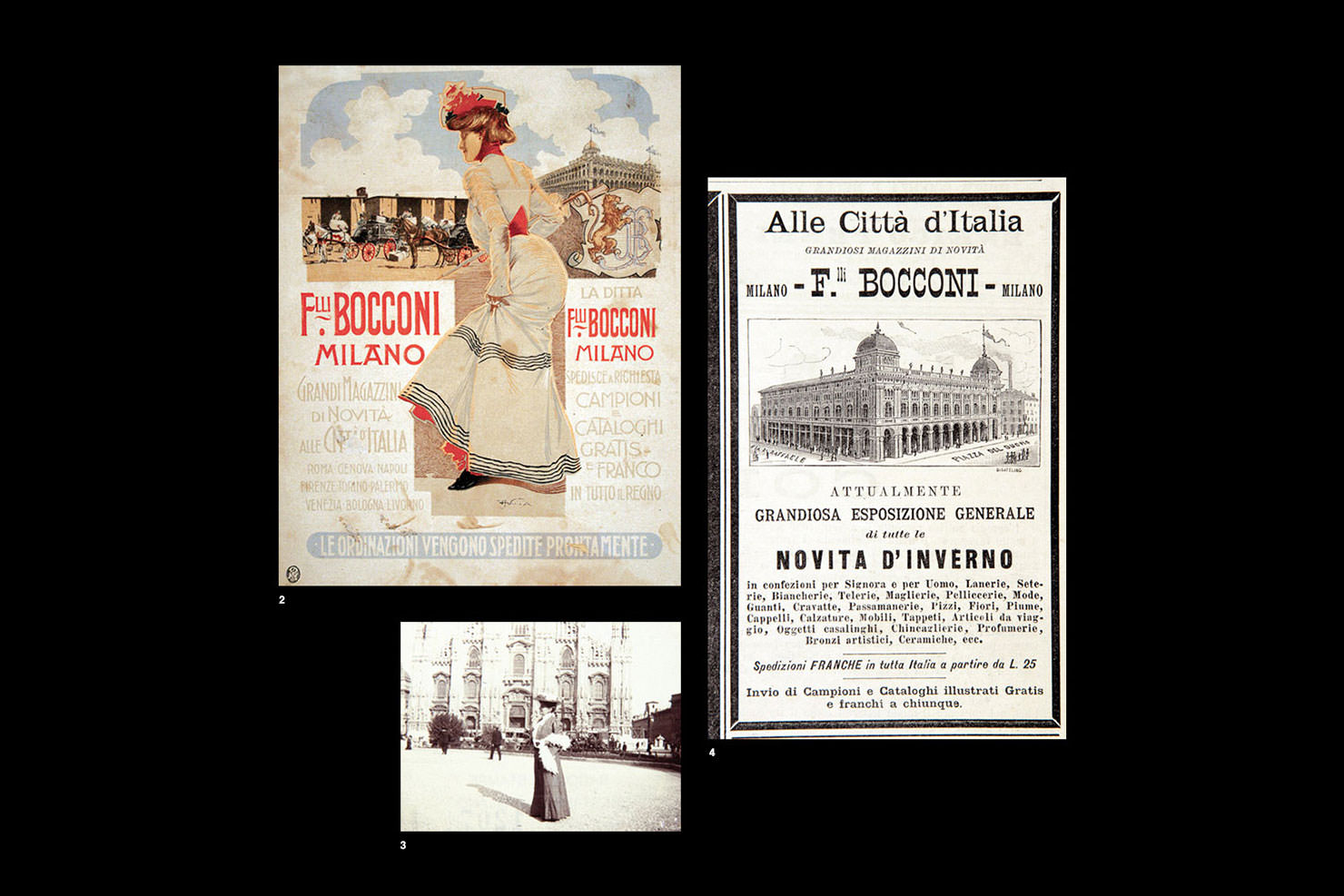

1 — Copertina dell’Album Milano elegante, 1899
2 — Aleardo Villa, Pubblicità dei Grandi Magazzini Fratelli Bocconi. Milano, 1898 circa.
Milano, Civica Raccolta delle Stampe Achille Bertarelli
3 — Piazza del Duomo. Veduta animata, 1892-1910.
Milano, Civico Archivio Fotografico (Fondo Collezione Lamberto Vitali)
4 — Inserto pubblicitario Alle città d’Italia, in “L’Illustrazione italiana”, 24 novembre 1889.
Milano, Civica Raccolta delle Stampe Achille Bertarelli
Image and imagination

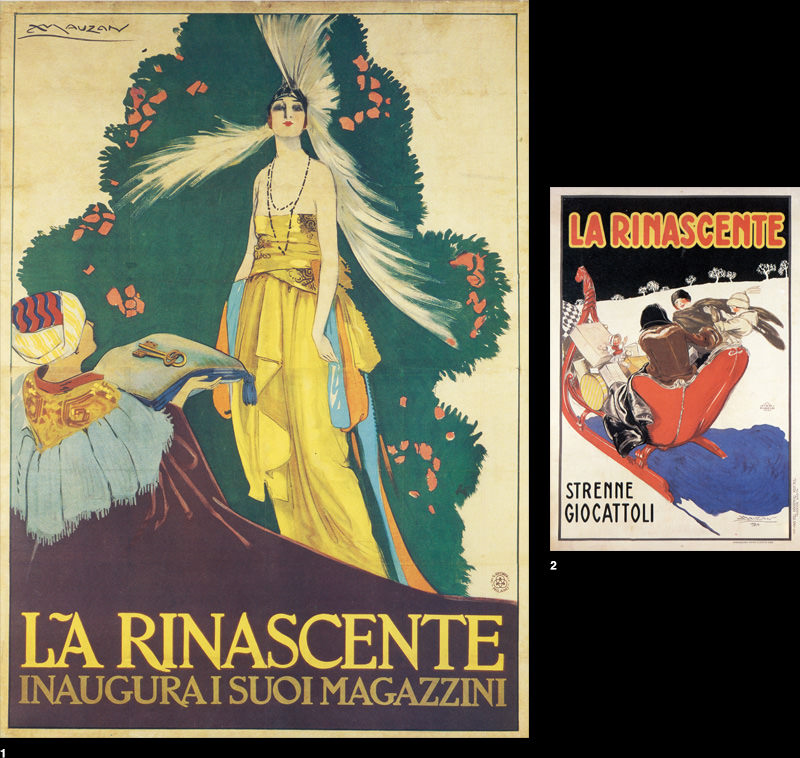
Among all the advertising media billboards took hold in the Liberty period as the typical urban means of communication, closely linked to rise of the mass society that seemed to thrive especially in capital cities. Created by artists who were willing to take up the challenge of the new techniques of graphic expression, these posters were the best tool to channel the imagery based on contemporary fashion designs and merchandise. The best examples are the billboards created by Leopoldo Metlicovitz or Marcello Dudovich. In the early twenties the latter, in particular, started his long association with la Rinascente in the portraying the image of the store in over a hundred posters.
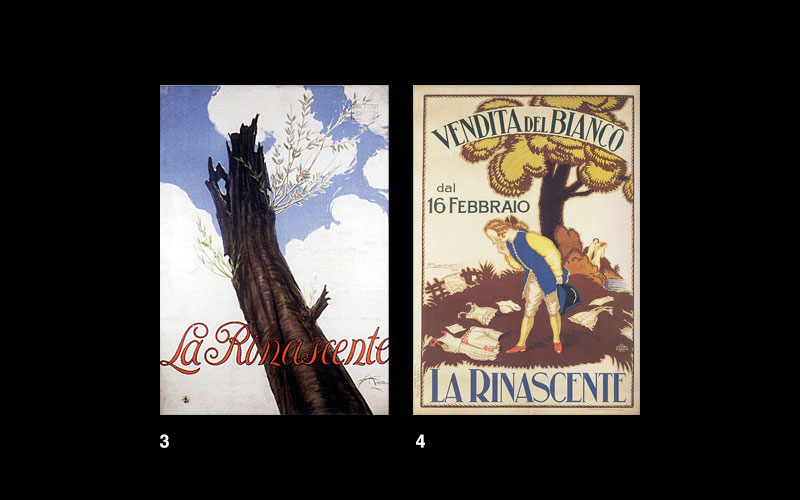



1 — Achille Luciano Mauzan, La Rinascente inaugura i suoi magazzini, 1917.
Treviso, Museo Civico Luigi Bailo, Raccolta Ferdinando Salce
2 — Achille Luciano Mauzan, La Rinascente, 1924.
Treviso, Museo Civico Luigi Bailo, Raccolta Ferdinando Salce
3 — Aldo Mazza, La Rinascente, 1921.
Milano, Civica Raccolta delle Stampe Achille Bertarelli
4 — Achille Luciano Mauzan, Vendita del bianco, 1924.
Treviso, Museo Civico Luigi Bailo, Raccolta Ferdinando Salce
5 — Piazza Italia alla Fiera Campionaria di Milano, 1929.
Archivio Storico Fondazione Fiera Milano
Reaching our centenary
In 2015, the year of Expo, we have celebrated our 150th anniversary from the time the Bocconi Brothers set up their retail enterprise. In 2017 we will celebrate the first 100 ye- ars of the brand named la Rinascente as conceived by Gabriele D’Annunzio for the new enterprise headed by Senatore Borletti. Over this last century and a half, la Rinascente has been the driving force behind modern retail strategies, fostered the birth of the brand “Made in Italy” as well as an instru- ment of democratization and a showcase for the new so- cial customs of the united and modern Italy.
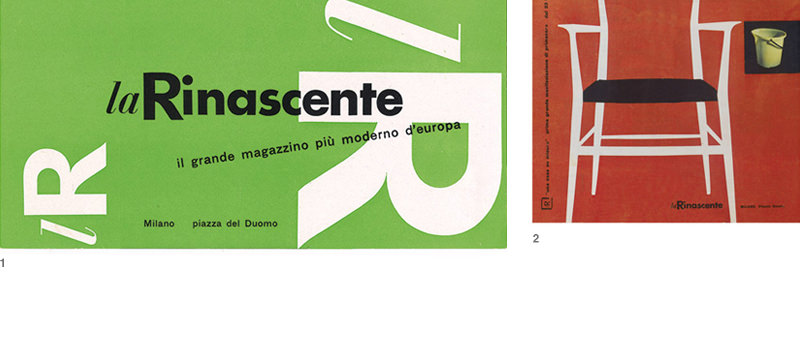
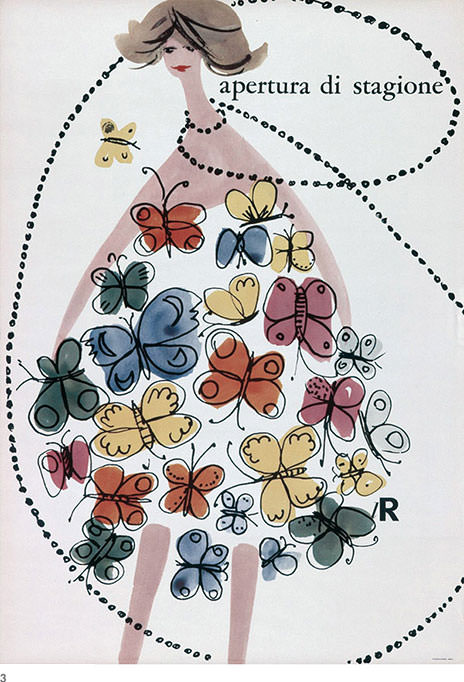
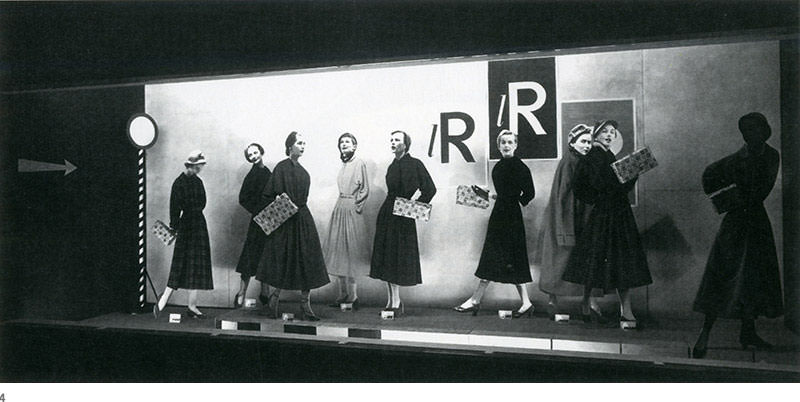

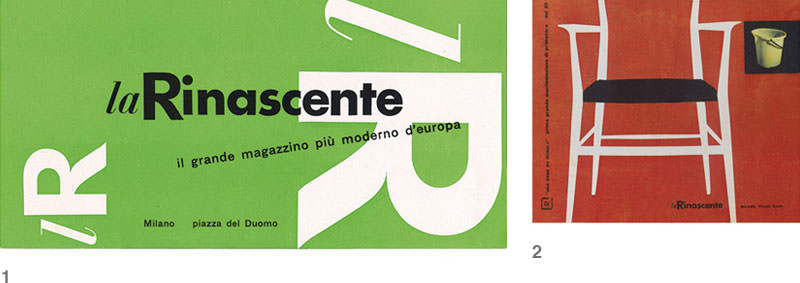
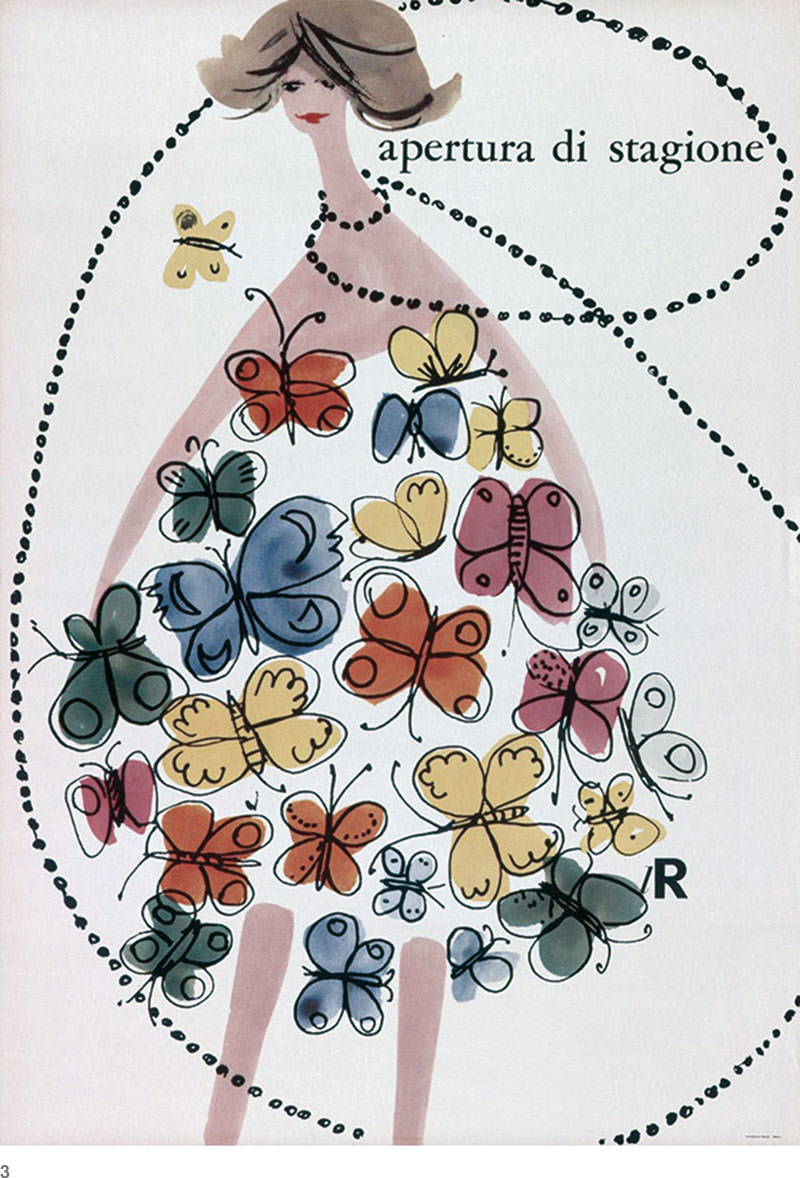

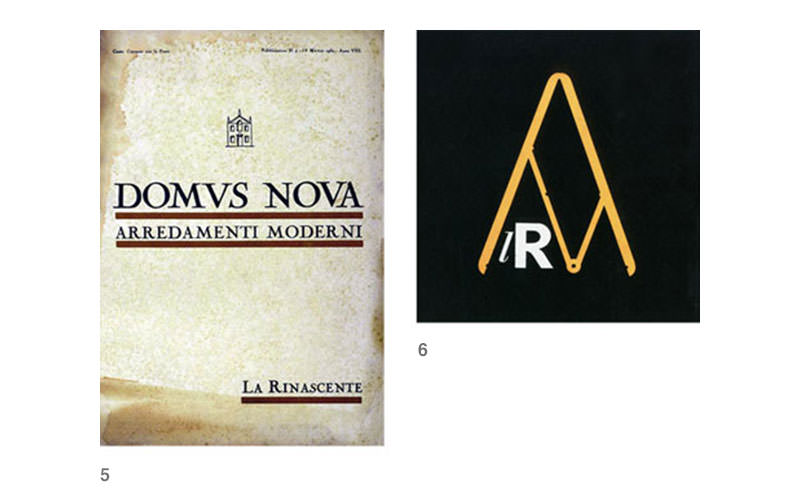
1 — Max Huber, Pieghevole La Rinascente il grande magazzino più moderno d’Europa, 1951.
Milano, Civica Raccolta delle Stampe Achille Bertarelli
2 — Catalogo Una casa su misura, 1957.
Milano, Civica Raccolta delle Stampe Achille Bertarelli
3 — Lora Lamm, Apertura di stagione, 1957.
Zurigo, Museum für Gestaltung
4 — Vetrina della Rinascente, 1950 circa
5 — Copertina del catalogo Domus Nova, 1930.
Milano, Civica Raccolta delle Stampe Achille Bertarelli
6 — Albe Steiner, Marchio del premio la Rinascente Compasso d’Oro per il disegno industriale, 1954